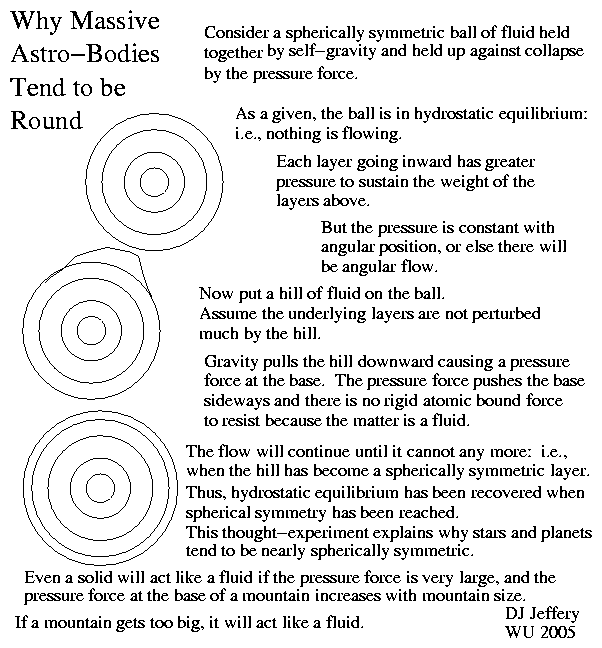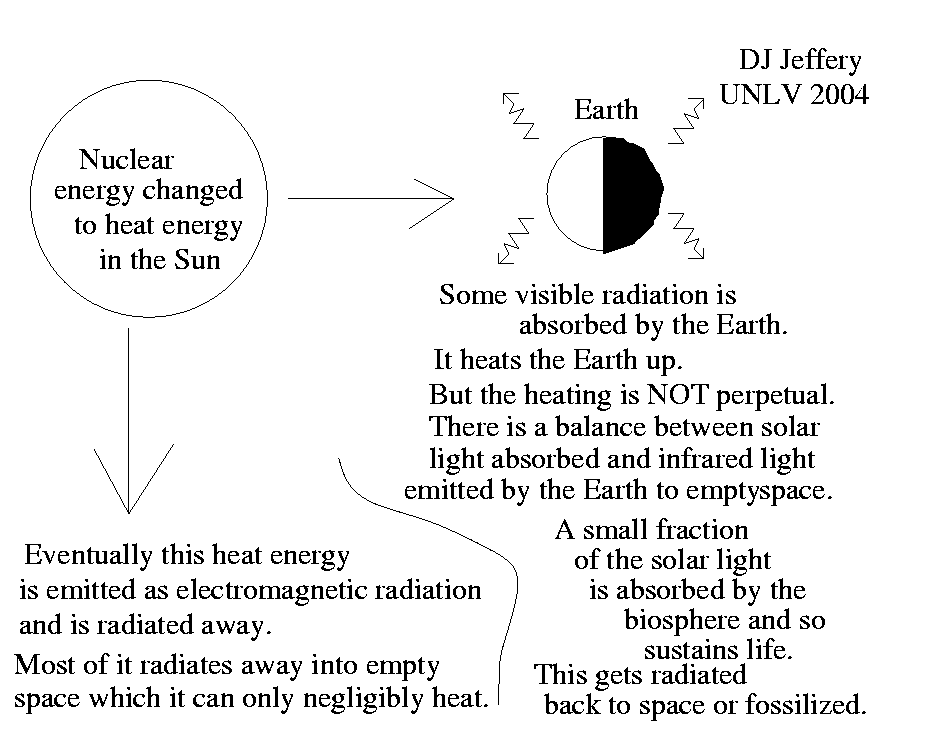- Introduction
- The Introduction of the Introduction:
To say the least, it's hard to sum up all the physics that one needs to know to understand all astronomy and physical cosmology---which is the science of the universe in broad outline.
-
By the way, in one sense, cosmology is a subfield of
astronomy---in another sense, it's the
other way around.
The figure below (local link / general link: orbit_astronaut.html) illustrates astronomy and astronautics.
As discussed earlier in IAL 0: A Philosophical and Historical Introduction to Astronomy, we do NOT yet have the final, eternal, fundamental theory of physics: Theory of Everything or TOE.
But we're NOT just sitting around Waiting for the TOE.
The physics we do have explains a lot and we hope that this physics will be explained fully by TOE and that TOE will help us to explain all cosmology which is illustrated in the figure below (local link / general link: cosmos_history.html).
- No Completely Logical Presentation of Physics:
There is NO completely logical presentation of physics---at least without infinite tediousness.
We just have to dive in and swim to a degree.
One obvious point is there is a lot of circularity in the definitions---but it's NOT a viscious circle---like in the figure below (local link / general link: ouroboros.html).
It's hard to pull the concepts apart from each other and define them without referencing each other.
In fact, practically speaking, it's impossible.
So to start describing one concept inevitably means describing others and an orderly one-concept-at-time description is nearly impossible---you just have to have patience that everything will make some coherent sense after awhile.
To a large degree, one has to accept physics as a package: the parts make most sense as parts of the whole.
By the way---in case you didn't know---physics is very mathematical, but we will skip math almost entirely. We do sometimes show formulae to show they exist and for contemplating them, but almost NEVER for calculating with them or analyzing them in detail.
- What is Physics?:
What is physics?
The short conventional answer is that physics is the science of matter and motion.
Light is usually NOT considered matter, but is considered in physics. But to be brief, we can include light under matter for the nonce. One could say "stuff and motion," but that sounds weird and pedantic.
For motion illustrated, see the figure below (local link / general link: muybridge_horse.html).
Many things.
Probably, the key one is to predict---and thereby understand---the future and past evolution of systems.
A system is any set of objects we are interested in---for example the Solar System. For the inner Solar System, see the figure below (local link / general link: solar_system_inner.html).
System and its special case physical system are further explicated in the figure below (local link / general link: system_environment.html).
-
But not "whole" here means what modern
cosmology makes it mean:
the average evolution
(as understood via Friedmann equation)
and the large-scale structure of the universe
(meaning structures from
galaxies upward).
The smaller stuff is the environment: e.g., us.
To make predictions we need those physical laws AND boundary conditions and initial conditions for the system.
Physical laws are what are generally true---or at least very generally true---and boundary and initial conditions are what are peculiar to the system.
-
Nota bene:
Predictions in physics
are generally solutions of
differential equations
which we explicate in the general statement in the
insert below
(local link /
general link: physical_law_solution.html).
- EOF
So we just tell stories---but physicists tell stories all the time to themselves---it's how we understand things up to a point---then the math kicks in. For storytelling, see the figure below (local link / general link: walter_raleigh.html).
So to start those stories what about "matter and motion"?
But even saying "matter and motion" implies a lot of understood concepts that actually need some definitions---like space and time.
- No Completely Logical Presentation of Physics:
- Newtonian Physics Redux
-
We covered Newtonian physics
in in some detail in
IAL 1: Scientific Notation, Units, Math, Angles, Plots, Physics, Orbits: Physics for Orbits
in two of inserts:
- Newtonian Physics:
Insert
Mechanics file:
newtonian_physics.html.
- The Basics of Reference Frames Relevant to Physics: Insert: Mechanics file: frame_basics.html.
- Inertial Frames Redux:
An important point about (physical) space is that it has active properties in several respects.
A one key property is that of having inertial frames of reference.
-
Recall a reference frame
is just a set of coordinates covering space that
you use to describe the locations and motions of objects.
It can just be an arbitrary set of coordinates in space or attached to
some physical structure.
-
In modern understanding is based on
general relativity (GR)
and in particular its axiom the
strong equivalence principle,
an ideal inertial frame
is a frame of reference
that is unaccelerated in
a free-fall frame
in a uniform gravitational field.
By unaccelerated, we include the idea that
the inertial frame
is NOT in rotation relative to the
the observable universe.
Now the ideal inertial frame is closely approached in many important cases. But in many important cases, it is NOT. But those cases can be treated using tidal forces and/or inertial forces which can convert any reference frame into an inertial frame. In particular, rotating reference frames (which are all important since all compact astro-bodies: stars planets, etc.) can be converted into inertial frame using the inertial forces the centrifugal force and the Coriolis force.
Note, if the acceleration of your reference frame relative to an inertial frame is small enough it can be neglected.
Actually, everyone knows about inertial frames even if they don't know the name inertial frame.
In everyday life, an inertial frame is just a reference frame in which motions behave as you ordinarily expect them too.
For example, the frame of reference of the Earth's surface.
But you say that's NOT a free-fall frame and the external gravitational field due to astronomical objects beyond the Earth is NOT uniform. No, but the center of mass of the Earth defines a free-fall frame since it is free falling in space and the non-uniformity of the external gravitational field is relatively small. So for most purposes, but NOT all, the Earth's surface adequately approximates an inertial frame.
-
However, the
Earth's surface
(i.e., the ground) is NOT
a sufficiently
inertial frame
for, e.g., NOT for long-range gunnery nor for
weather.

Caption: "2004-2007 Toyota Prius photographed in USA."
The Prius: nothing special to look at, but it gets about 45 miles per gallon which made it the most fuel-efficient car sold in the US circa 2007.
Of course, in 1991, the standard GM Geo Metro got 60 miles per gallon at least according to the specifications.
Credit/Permision: User:IFCAR, 2007 / Public domain.
Image link: Wikipedia: File:2nd-Toyota-Prius.jpg.
Everything is normal throwing balls, etc., around in unaccelerates cars. But if a car accelerates, you know that motions are affected: e.g., you get thrown forward relative to the car if you decelerate to fast---and arn't wearing your seat belt.
-
To expand a bit.
If your car accelerates relative to the ground, you do have a sense of acceleration.
If you are moving with the car that sense of acceleration is the car exerting a force on your body to accelerate you with the car.
Why is a force needed in one case and NOT the other?
Well forces are needed to accelerate relative to an inertial frame and NOT NECESSARILY relative to NON-INERTIAL FRAMES.
An everyday observation really, but profound.
What if you are outside the accelerating car and you say that car defines your frame of reference. Well the you, the Earth's surface, and everything at rest with respect to the Earth's surface are in acceleration relative to your defined frame of reference with NO forces acting on any of those things in apparent violation of Newton's 2nd law of motion (AKA F=ma). But actually Newton's 2nd law is defined relative to inertial frames and so there is NO violation, in fact.
Forces are needed to accelerate relative to an inertial frame and NOT NECESSARILY relative to NON-INERTIAL FRAMES.
An everyday observation really, but profound.
- Physics Terms:
Before proceeding, we should try to define our physics terms---but admitting some inescapable circularity at the start.
- Now what is an acceleration actually?
It is a change in velocity relative to an inertial frame.
-
A frame of reference is
just a coordinate system that one lays on space.
An inertial frame as describe above is one to which all physical laws are referenced, except general relativity which tells us what inertial frames.
In physics, we almost only use inertial frames which may be only approximate inertial frames or non-inertial frames converted to inertial frames using inertial forces.
Hereafter, in IAL 5: Physics, Gravity, Orbits, Thermodynamics, Tides, we will always assume inertial frames.
Often we use inertial frames that are attached to physical bodies: in everyday life the ground and in astronomy, center-of-mass (CM) inertial frames: i.e., those whose origin is the center of mass and unrotating with respect to the observable universe.
A change in MAGNITUDE and/or DIRECTION is an acceleration---which is also a vector.
Note, velocity is dependent on your inertial frame of reference.
What velocity you have depends on what inertial frames you measure that velocity with respect to.
- Now what is force?
A force is a physical interaction on a object that can cause acceleration relative to an inertial frame.
See the examples of forces in the figure below (local link / general link: free_body_diagram_object_wedge.html).
Balanced forces give NO acceleration.
In order for the force concept to be of any use or significance, one must have laws of force which are independent of an object's acceleration.
And, of course, we do have such laws.
And by the way force is vector.
- Physics Terms:
- Space
-
Space is such a basic
item of our existence that it's to explain or define in brief or at length.
- Flat Space:
Historically, space was assumed to the space of 3-dimensional Euclidean geometry that we learn in high school.
Space with Euclidean geometry is Euclidean space which is synonymized as flat space.
An illustrutation of 2-dimensional Euclidean geometry is shown in the figure below.
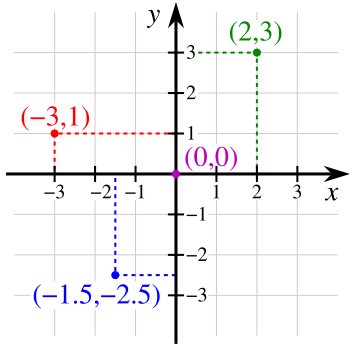
Caption: "Small portion of the Cartesian coordinate system, showing the origin, axes, and the four quadrants, with illustrative points and grid."
Cartesian coordinates are used to map Euclidean space.
Credit/Permission: K. Bolino (AKA User:Kbolino), 2008 / Public domain.
Image link: Wikipedia: File:Cartesian-coordinate-system.svg.
But different space geometries are possible.
The geometry of the curved surface of a sphere is NOT the same as that of flat 2-dimensional surface.
Curved 3-dimensional geometries can exist mathematically. They are NOT easy to picture.
In general relativity, curved 3-dimensional geometries do exist in the physical world.
Accumulations of mass actually cause curved 3-dimensional regions of space.
You will be happy to know that in the current standard model of the observable universe---which is called Λ-CDM model---the overall geometry of physical space is very nearly flat space: i.e., the space of 3-dimensional Euclidean geometry.
From the Λ-CDM model, we obtain the mass-energy contents of the observable universe illustrated in the figure below (local link / general link: pie_chart_cosmic_energy.html).
All mass-energy curves space to some degree.
Near dense acccumulations of mass, significant space curvature is expected: e.g., near black holes.
But the ordinary geometry of space, we can think of most purposes as flat---which is good because our ordinary intuition about space is NOT violated.
(see illustrative figure below: local link / general link: spacetime_curvature_earth.html),
But we understand a lot about space anyway: it has extent, it's where we find things, things can be near or far---and this nearness and farness is quantified as displacment or more loosely distance.
- Time
-
If you thought space was tricky,
time is probably even worse.
- A Start on Time:
An object can occupy different positions in space and NOT simultaneously.
In fact, there are a continuum of positions as it moves from one place to another.
Time passes while things move.
Immediately, one sees that our notion of time is linked to our notion of space---time without space is hard to define.
This linkage or coupling becomes complex in modern physics as we'll discuss below---but NOT discuss in detail.
In physics, there is this parameter time in fact.
This parameter time increases as things move about.
- Clocks:
There are certain systems that do repeat motions in equal periods of the parameter time.
We can call these systems clocks.
For an astronomical clock, see the figure below (local link / general link: strasbourg_cathedral_astronomical_clock.html).
Of course, we didn't need a mathematical physical theory to be aware of time---changes in position and clocks made us aware of time.
We---humankind---good old homo sapiens---have always had clocks---and so probably has all of life.
The clocks were all repeating systems (periodic systems) of some kind.
For most of human history, astronomical cycle clocks had precedence: i.e., the astronomical cycles of the Sun and Moon.
The Sun and Moon were unique and massive and their periodic motions (i.e., astronomical cycles) could easily be counted.
It was probably assumed that those astronomical cycles were exactly regular and measured time itself.
So we counted solar day (current mean value 86400.002 s) lunar months (mean value 29.530588861 days (J2000)), and solar years (mean value 365.2421897 days (J2000))
The days of the lunar month could be correlated with the lunar phases which are illustrated in the figure below (local link / general link: moon_lunar_phases_animation.html).
- Non-Astronomical-Cycle Clocks:
All other repeating motions were obviously irregular and NOT eternal compared to the astronomical cycle clocks of the Sun and Moon
These irregular clocks include:
- The climatic seasons. They stay pretty close to the
Sun clock, but
NOT perfectly.
- The
chonobiologic rhythms---flowers
blooming in the spring, etc.---that in many cases evolved in response to the
astronomical cycles of the Sun:
the solar day and
solar year
and their effect on the physical environment on Earth.
And---in probably much more limited way---to the lunar month through it's relation to tides.
Maybe many animals are probably conscious of the passing of time mainly through the solar day.
- The pulse---usually
measured from the radial artery---can be used
for short-time time measurements.
It tracks the beating of the heart.

Caption: Ulnar and radial arteries from Gray's Anatomy (1918).
Credit/Permission: Publisher of the 1918 edition, 1918 / Public domain.
Image link: Wikipedia: File:Gray528.png.
- The life cycles of animals and especially our own life cycle has
also been conspicuous and can be used to keep time---to this
day we talk about human lifetimes and
generations.
We've always been conscious that our days if NOT numbered are distinctly finite---it causes a certain anxiety. We ponder our monuments. See the figure below (local link / general link: giza_pyramids.html).
But they had problems too:
- Their periods are NOT
commensurable
which led to a lot of difficulties in trying to keep time with all of them
simultaneously.
The mean lunar month = 29.530588861 days (J2000)), and mean solar years = 365.2421897 days (J2000)).
Trying to keep a lunisolar calendar was tricky as discussed in The Moon and Timekeeping">IAL 3: The Moon: Orbit, Phases, Eclipses, and More: The Moon and Timekeeping.
Even just keeping a solar calendar calls for leap years and a somewhat tricky rule for keeping official years consisting of integer number of days.
But that's all another story. In the modern age, we do it with the Gregorian calendar.
- For short time measurements during a day, the
astronomical cycle clocks were NOT
fully satisfying.
They were sometimes hard to read precisely or at all if the sky were cloudy.
-
Actually, water clocks
count a continuous flow of water
and so a continuous steady-state motion rather than a repeated motion.
So they are a bit distinct from most clocks.

Caption: "The dial of the clock inside Wells Cathedral."
This is an astronomical clock used for tracking the Sun and Moon, NOT daily time.
The article on the Wells Cathedral clock isn't clear whether this is the original or just a facsimile.
The original probably dates to sometime between 1386 and 1392.
Credit/Permission: © User:Cormullion 2004 CC BY-SA 2.5.
Image link: Wikipedia: https://en.wikipedia.org/wiki/File:Wells_cathedral_clock_dial.jpg.
The theoretical position of measuring time changed considerably with the advent of Newtonian physics in the 17th century.
Newtonian physics gave a physical explanation in terms of basic laws as to why periodic systems should count the parameter time discussed above.
There was no "Shock of the New" in that ideal mechanical clocks were shown to count the same time as the astronomical cycle clocks.
But there was one shock: the astronomical cycle clocks could NOT keep time perfectly either.
Small perturbations would always cause them NOT to repeat in exactly equal periods.
In the modern age, to measure time to high accuracy, we use atomic clocks.
- Atomic Clocks:
According to quantum mechanics (our modern theory of microscopic systems), an atomic clock should keep time exactly regularly---if there are no PERTURBATIONS.
But there are always are PERTURBATIONS.
Nevertheless, the best atomic clocks measure time more accurately than anything we know of.
But atomic clocks have a problem. They are delicate things and if NOT maintained, they stop. The astronomical cycle clocks of Sun and Moon do NOT keep time so accurately, but will NOT stop for gigayears.
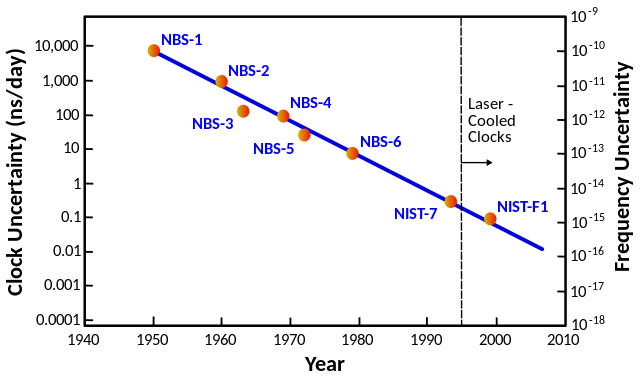
Caption: Graph showing the improvement in accuracy of atomic clock as a function of year based on data from National Institute of Standards and Technology (NIST).
-
In the period
1901--1988,
NIST
was the
National Bureau of Standards (NBS).
This made a lot of sense: call the National Bureau of Standards the National Bureau of Standards.
Image link: Wikimedia Commons: File:Clock accuracy.svg.
- Time Dilation:
But there is a big complication arising in modern physics that was shown by special relativity and general relativity.
Time in general flows at the different rates in different frames of reference that are in relative motion and in frames in different gravitational fields.
This effect is given the general name time dilation.
-
Interestingly,
Newton himself wondered if
time flowed the same everywhere and
everywhen.
He admitted the possibility that maybe NOT.
But that time did flow the same always was the simplest hypothesis and NO observation contradicted it in his time and until sometime after 1900.
If you initially synchronized two clocks in these two frames, as time passed---as measured in either frame---the two clocks would increasingly give different times when measured simultaneously by any observer---according to her determination of simultaneity.
It doesn't matter what the clocks are.
Time dilation is well understood and we can calculate the time discrepancies that arise.
We do NOT perceive time dilation in everyday life because the time discrepancies in everyday life are minute.
But time dilation is experimentally verified.
One example, is general relativity:
-
The deeper one is in gravitational field
(a gravitational potential to be a bit more precise), the slower time passes relative to
to infinity (where there is vanishing gravitational field).
Gravitational time dilation has been verified using atomic clocks.
The time discrepancies for terrestrial experiments are of order nanoseconds: i.e., of order 10**(-9) seconds???.
It's also important in technology. For example, for keeping modern standard times, such a Coordinated Universal Time (UCT) used for civil purposes, must account for time dilation to keep the standard times exactly the same for everyone.
-
Bureau International des Poids et Mesures (BIPM): UCT
maintains UCT:
most significant countries belong to it including the
US
(BIPM: Members).
The coupling of space and time in special relativity and general relativity is so much a part of those theories that a joint word was needed.
So in relativity-speak, one speaks of spacetime.
In a very general sense, spacetime is the realm of physics.
- Cosmic Time:
UNDER CONSTRUCTION, don't read
We can never know it so precisely as atomic clocks, but it is the fundamental time for the observable universe.
age of the observable universe = 13.797(23) Gyr (Planck 2018)
Cosmic time is illustrated in the figure below (local link / general link: cosmos_history.html), we don't have the final, eternal, fundamental theory of physics: Theory of Everything or TOE.
- Clocks:
- Mass
-
Mass
can be described as the stuff of existence.
Mass is the property is the property of bodies to resist acceleration.
Sometimes it's called the quantity of matter and that's sort of helpful---but if you ask what it means, one can has to we quantify matter by its resistance to acceleration.
-
One can had that for objects of the same density (mass per unit
volume), that mass is proportional to volume, and so is a measure
of quantity.
One can also say that for objects made of all of the same microscopic particle (which all have identical mass or nearly) that mass is proportional to particle number, and so is a measure of quantity.
The gravitational force on mass is what we measure by weighing. For an example of weighing, see the figure below (local link / general link: anubis.html).
The point at the moment is that mass has two important aspects: resistance to acceleration and its role in gravity.
In Newtonian physics, that mass has these two aspects is just a coincidence.
In general relativity, the two aspects are fundamentally related---but we won't go into that in our discussion.
- Energy
-
Now what about energy?
- Short Definition
and Extended Explication of Energy:
For the short defintition and an extended explication of energy, see the insert below local link / general link: energy_explication_4.html.
- A Less Elaborate Discussion of Energy:
We think of energy as being in things.
-
We think of food and gasoline, for example
as containing energy.
And with the that energy we can make changes.
Of course, the "thing" the energy was in changes when energy is removed or added.
Energy is a parameter or characteristic of the "thing".
Saying structure or physical system is a bit more physicsy sounding than "thing".
- The Units of Energy:
Of course, energy is quantified and that requires units.
In fact, you are all used to thinking about energy, but probably NOT in the Metric System unit of energy which is the joule (J) which was named for James Joule (1818-1889)---see the figure below (local link / general link: james_joule.html).
So a watt is a joule per second.
-
For example, a 100-W light incandescent light bulb
transforms 100 J per second of electrical energy into
electromagnetic radiation energy---but
actually mostly as infrared light, and
NOT
visible light.
Incandescent light bulbs are only a few percent efficient (i.e., power out in visible light/power in), and so will likely be completely phased out in a few years after circa 2025.
Here's a table of energy unit conversions just to clue you in.
----------------------------------------------------------------------------------- Energy Unit Conversions ----------------------------------------------------------------------------------- Weird unit In convenient Comment metric units ----------------------------------------------------------------------------------- 1 food calorie 4.1868 kJ Typical human food needs are in the range 2000--3000 food calories. 1000 food calories 4.1868 MJ per day. That turns into 8--12 MJ. So the megajoule is a perfectly convenient unit for food energy. It's better than food calories. 1 calorie 4.1868 J A food calorie is really a kilocalorie. The real calorie is the amount of energy needed to raise the temperature of one gram of water by 1 degree Celsius. Various versions exist because the amount of energy needed varies with conditions. The shown one is the International Steam calorie (See Wikipedia: Calorie). 1 kilowatt-hour 3.6 MJ The kilowatt-hour is hybrid unit that is (kilojoule/second)*hour. The MJ is good-sized replacement. Electric companies should bill in MJs. 1 Btu 1.0545 kJ British thermal units of slightly different size still linger around. Kilojoules can obviously replace them. 1 kg of gasoline 44--45 MJ About 5.5 times daily human food needs. You could live on a about 0.2 kg of gasoline. 1 kg of oil 41.868 MJ This is standard definition since the chemical energy content of oil varies. It looks like the calorie digits. barrel (bl) of oil 6.12 GJ This is approximate. The oil equivalent industry insists are reporting oil in barrels---though no one has put oil in barrels in a jillion years (to be precise). Why NOT just report oil quantities in energy equivalent since energy content is the key issue. 1 Mbl of oil 6.12 PJ World daily consumption is often given in mbls. 1 Gbl of oil 6.12 EJ World yearly consumption is often given in Gbls. ----------------------------------------------------------------------------------- Source: Wikipedia: Energy unit conversions. ------------------------------------------------------------------------------------ Forms of Energy Redux:
A non-exhaustive list of energy forms was given above in subsection Short Definition and Extended Explication of Energy. As stated there, it is almost impossible to have definitive list because there are different ways of defining the forms of energy and the form categories overlap.
To complement the list in subsection Short Definition and Extended Explication of Energy, we list here of the forms of energy we often use with some discussion:
- Kinetic energy (KE): The
energy of motion.
It has a simple formula for an object:
E=(1/2)mv**2 , where m is the object mass and v is the magnitude of velocity of the center of mass of the object. - Potential energy (PE): The
energy of position in a field
of force.
A field of force is just a region of space where a particular force can be exerted.
Examples are the graviational field and the electric field.
So there is gravitational potential energy and electrical potential energy.
There are other forms of potential energy too.
- Heat energy: It's the
energies associated with microscopic
motions and structures.
-
MICROSCOPIC in physics jargon means molecular size or smaller usually: i.e.,
size scales of 1 nanometer = 1**(-9) meters.
But the word is used loosely MICROSCOPIC. All fields need flexible jargon.
Heat energy sums up to MACROSCOPIC amounts.
And humans are quite sensitive when the amount of it per unit mass is too high or too low: the material is hot or cold.
The proper name is internal energy rather than heat energy or heat.
But, in fact, many people just say heat for internal energy even if they never do in writing.
- Chemical energy It's
the energy of
chemical bonds.
This means it's actually the electrical potential energy and kinetic energy of chemical bonds.
- Nuclear energy It's the
energy of nuclear bonds.
This means it's actually the nuclear potential energy and kinetic energy of the atomic nucleus.
- Electromagnetic field energy
The energy of
electromagnetic field.
Often we can partition this energy
into the energy of
the electric field
and the energy of
magnetic field.
- Electromagnetic radiation energy
The energy of
electromagnetic radiation or
light.
The electromagnetic spectrum and its conventional wavelength bands are illustrated in the figure below (local link / general link: electromagnetic_spectrum.html).
Electromagnetic radiation energy is a key means by which energy and information are transferred.
The transferrals are both over short distances and times as from the lights in this room and long ones like across the observable universe and everything in between.
A universe without electromagnetic radiation would rather limited to say the least.
- Rest mass energy
Let's wait to discuss this in section E=mc**2.
- Etc.
Where did all these forms come from.
Historically, kinetic energy was the first form of energy to be recognized in in the early 19th century (see Wikipedia: Energy: History).
The other forms were mostly recognized/discovered in the course of 19th century.
In a sense, folks invented new forms of energy in order to maintain the principle of conservation of energy.
So one might ask is conservation of energy a sort of an accounting trick.
Yours truly thinks the answer is no.
The new forms of energy were always there to be discovered which yours truly thinks means energy is a real thing and so is conservation of energy.
The whole question of existence of energy was transformed by the discovery of special relativity in 1905.
We discuss this just below in section E=mc**2.
- A Less Elaborate Discussion of Energy:
- E=mc**2
-
The discovery of special relativity in
1905
by Albert Einstein (1879--1955)
radically transformed some of our ideas about
energy---and
mass---and
physical space---and
time.
- E=mc**2 Explicated:
E=mc**2 is explicated in the figure below (local link / general link: e_mc2.html).
- Rest Mass in General:
Rest mass is just the mass of a physical system observed in an inertial frame of reference in which the physical system is at rest.
You can imagine enclosing the physical system in black box so as NOT to see any moving parts inside.
If the physical system is moving relative to the inertial frame of observation because kinetic energy has mass.
Now if you look inside the system you may see that there are moving parts.
So some of the rest mass of the system can be the mass of the kinetic energy of the parts.
The higher the velocity of those parts, the higher the kinetic energy of the system and the higher it's mass.
The kinetic energy adds
kinetic energy / c**2 to the rest mass.
Rest mass by E=mc**2 is the same as rest mass energy.- The Rest Mass of Baryonic-Matter Particles:
The ordinary-matter particles of physics are protons, neutrons, and electrons.
--------------------------------------------------------------------------------------- Ordinary-Matter Particle Properties --------------------------------------------------------------------------------------- Particle mass (kg) mass (AMU) E (MeV) electric charge --------------------------------------------------------------------------------------- proton 1.6726*10**(-27) 1.0073 938.27 +e neutron 1.6749*10**(-27) 1.0087 939.57 0 electron 9.1094*10**(-31) 5.4858*10*(-4) 0.51100 -e --------------------------------------------------------------------------------------- The values have been rounded-off to 5 digits. The atomic mass unit (AMU) is 1.660538782(83)*10**(-27) kg and is by definition the 1/12 of the mass of an unperturbed Carbon-12 atom. e is the elementary charge which is 1.602176487(40)*10**(-19) coulombs. The coulomb is the macroscopic unit of charge. A coulomb per second is the ampere, the familiar unit of current.
All ordinary matter throughout the observable universe is constructed of the ordinary-matter particles.
-
Note, yours truly
does NOT use the word fundamental particle---which means a particle with no known
constituents.
The electron is considered a fundamental particle.
But nowadays, protons and neutrons are believed to be made of quarks---which we discuss below in section Bound Systems.
They can be created and destroyed---and those processes go on all the time---but in ordinary conditions throughout the observable universe at relatively low rates.
-
You can make these particles by supplying
the energy to make up their
rest mass energy and recover that
energy back by destroying them.
In practice the supplied and recovered energy is often that of photons (i.e., the particles of light).
Creation and destruction, of course, require other conditions than just ones of energy.
-
"Luminous" is needed above since
the observable universe
contains lots of dark matter
and dark energy which are NOT
made of the ordinary-matter particles.
What dark matter and dark energy are NOT really known---but they are important for gravitationally and in cosmology as we'll discuss in IAL 30: Cosmology elsewhere as needed.
For the mass-energy distribution of the observable universe including the dominant components dark energy and dark matter, see the figure below (local link / general link: pie_chart_cosmic_energy.html).
This fact is what gave rise to the historical conservation of mass for physical systems where heat, electromagnetic radiation, and/or mechanical work (which a macroscopic energy transfer process) was emitted or absorbed, but no MACROSCOPIC flows of matter were observed.
Actually, there is no conservation of mass for such physical systems---if their energy content changed, their mass changed---to be exact, if their energy changed by Delta E, then there mass changed by Delta m=Delta E/c**2.
But before 1905 or so, such changes in mass were undetectably small.
For example, say a chemical reaction caused a physical system to emit 1 gigajoule of heat---this amount of energy is what a human need for about 100 days.
How much does the mass of the physical system change by?
E/c**2 = 10**9 J /((3*10**8)**2) = 10**(-8) kilograms.
Until modern times such mass changes were too small to detect.
Note, if that heat did not get out of the system, the mass of the system would NOT change.
There would just be change in the form of some of the energy from chemical energy to heat.
People were able to observe and measure the transformations of energy using the known formulae for the various known forms of energy, but they didn't notice the accompanying mass changes since they were too small.
So up until 1905, the principles of conservation of mass and conservation of energy were thought to be distinct.
Since 1905, mass and energy have been recognized as the same thing, and the principles of conservation of mass and conservation of energy are recognized as the same principle.
Mass and energy only appeared to be different things since different properties were associated with them and since most ``mass-energy'' is in the rather stable form of the ordinary-matter particles, and so doesn't undergo transformations at a high rate in ordinary circumstances.
Now what if you could make a large transformations of the rest mass energy of ordinary-matter particles.
For example, say we could convert 1 kg of iron into kinetic energy.
The energy amount is E=mc**2 = 1 * (3*10**8)**2 = 10**17 J = 10**17 J * (1 Mt/(4.184*10*15 J)) = 25 Mt , where 1 megaton (Mt) is the chemical energy released by 1 megaton of TNT (Wikipedia: TNT equivalent.Of course, TNT equivalent is used to measure the energy released by nuclear bombs.
-
The ton of kilotons (kt) and megatons (Mt) are actually metric tonnes of 1000 kg (i.e., 1 megagram).
Castle Bravo test at Bikini Atoll in 1954 (see figure below: local link / general link: explosion_1954_bikini.html) was the biggest test US nuclear bomb at 15 Mt---earlier tests at Bikini inadvertantly gave a name to innocent form of beach wear.
The Soviet Tsar Bomba had a yield of 50 Mt.
But fortunately such conversions are hard to do.
In principle, they can be done, but in practice on nuclear bomb scale they are impossible---which in our bombing time is a good thing.
-
For example, the rest mass of
a particle can all be converted into
electromagnetic radiation
by interacting the particle with its antiparticle.
For example, the antiparticle of the electron is the positron which is seemingly nearly the same as the electron, except that it has charge +e.
Antiparticles exist both in nature and in the laboratory, but they never accumulate into MACROSCOPIC amounts as far as we know.
For good reason---they annihilate with their corresponding particles before this can happen.
So if you had a kilogram of antimatter, you maybe could cause a big explosion by bringing it into contact with a kilogram of matter.
But you can't accumulate a kilogram of antimatter.
There are people working making larger amounts of antimatter: for example antihydrogen has been made since 1995, but only in MICROSCOPIC quantities.
You change nuclear bonds either breaking up nuclei ( nuclear fission) or building them up (nuclear fusion).
The process is analogous to changing chemical bonds to absorb or emit chemical energy.
But the energy of nuclear bonds is of order 10**6 times that of chemical bonds.
-
The spent fuel does have less mass than the initial fueld because emitted energy
of the transformations is emitted as heat.
So much energy from so little fuel.
Well nuclear power has developed a place in the modern world---it produced about 14 % of the world's electrical energy in 2007 (Wikipedia: Nuclear power)---but it is far from dominant and it may never be dominant.
By the way, Einstein's disovery of E=mc**2 is NOT the singular important invent in the development of nuclear energy---it is one of other important ingredients.
- Mass without Rest Mass:
Certain particles are said to be massless particles.
They photon (the particle of light), gluon (a particle that causes the strong nuclear force), and other hypothetical particles.
These particles actually have mass since they have energy, but they have NO rest mass.
Saying REST MASSLESS is just too longwinded I guess though more accurate.
How can massless particles have no rest mass?
They are never observed at rest.
They always move at the vacuum light speed relative to any local observer???. See vacuum light speed illustrated in the igure below (local link / general link: light_speed_earth_moon.html).
Our ordinary ideas of relative motion get upset by this.
In special relativity In special relativity and general relativity, this upset manifests itself by having time and length become frame-dependent quantities.
Actually, massless particles can contribute to the rest mass of physical system if they are included in system.
For example, electromagnetic radiation contained in internally reflecting box contributes its energy to the box system viewed as a whole, and so contributes to its rest mass.
The mass of massless particles acts just like other massless particles, of course.
It resists acceleration and it is the source of gravitational field and is the object of the gravitational force.
Note also, particles with rest mass can NEVER move at or above the vacuum light speed.
They would have to have infinite kinetic energy to do so in special relativity and general relativity.
- The Energy of Space:
In discussing inertial frames, we argued that physical space has properties and this is what made inertial frames inertial frames.
Physical space has other properties.
One of which may be to have an average energy content.
In inflation cosmology, transformations between different states of space energy can release energy that creates pocket universes.
Universe as we know it would be one of these pocket universes.
The pocket universes are embeded in a much larger background universe.
There is also the dark energy whose nature is pretty much unknown, but seems to be necessary to drive the acceleration of the expansion of the universe which has been observed since about 1997.
- Rest Mass in General:
Many people just call this equation E=mc**2, but one can also call it the mass-energy equivalence.
Note, E is energy, m is mass, and c**2 is the vacuum light speed squared.
But what does E=mc**2 mean?
It's primary meaning is that mass and energy are really the same thing.
The properties we associate with mass and the properties we associate with energy are both the properties of the thing we can call either mass or energy.
In relativity jargon, one frequently says mass-energy to emphasize the identity.
So an amount of mass is an amount of energy and an change in energy is a change mass.
We have already discussed E=mc**2 and mass-energy in subsection Short Definition and Extended Explication of Energy. In this section, we elaborate on these topics.
For me this is a strong proof that energy is a real thing, NOT just an accounting trick---it measures resistance to acceleration and it gravitates.
How much more real can it be?
In section Mass, we said mass can be described as the stuff of existence.
So energy can be described as the stuff of existence too.
In fact, because the word energy is more associated with changes in the physics, I think that saying energy is the stuff of existence is the best locution.
Energy is also very much the stuff of physics too since all physical effects can be discussed in terms of energy and long with a lot of other concepts.
A series of events can often be described as a series of energy transformations.
-
For example, you eat food.
The chemical energy of the food becomes a different kind of chemical energy in your body.
This chemical energy can get changed into kinetic energy, gravitational potential energy, and waste heat.
The overall process just described is illustrated in the figure below.
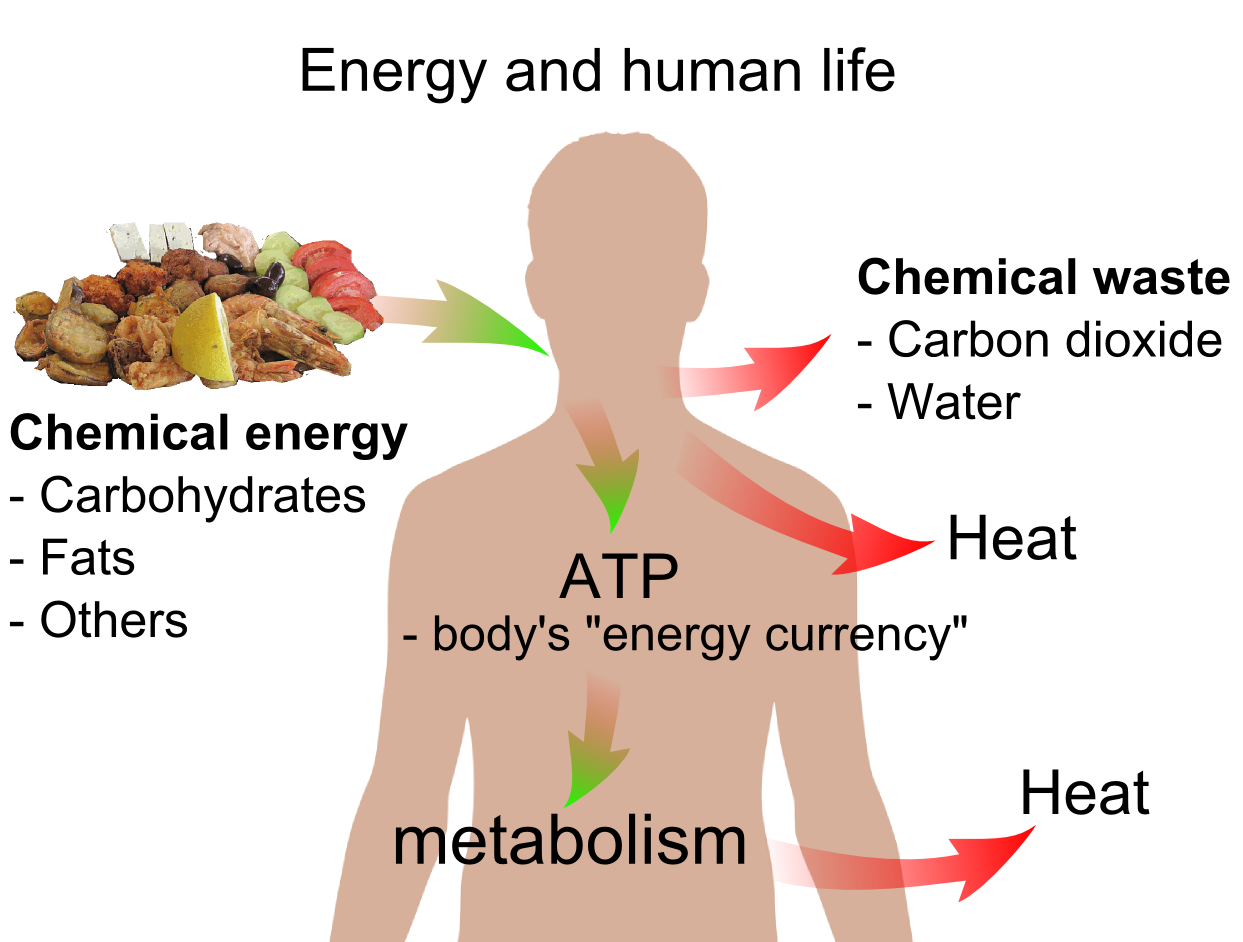
Caption: Energy in, energy out. Kinetic energy comes out too.
Credit/Permission: 2009 / Public domain.
Image link: Wikipedia: File:Energy and life.png
- Forces
- What is Force?
As noted in section Space, a force is a physical interaction on a object that can cause acceleration relative to an inertial frame.
This interaction is illustrated in the figure below.
Force also mediate the change of energy forms.
For example, if an object is accelerated by a force, its speed might (but NOT necessarily will) increase and that means its kinetic energy will increase.
-
An acceleration can be just a change in direction without a change in speed.
In that case, kinetic energy
does NOT change.
- Bound Systems: A First Look:
If forces are balanced, then you can create structures or, in other words, BOUND SYSTEMS.
Usually by BOUND SYSTEM, you mean a STABLE BOUND SYSTEM.
A ball at the bottom of curved pocket---which in physics jargon would be a gravitational well---is in a stable BOUND SYSTEMS: small perturbations will make it oscillate about, but it can't get out of the pocket.
On the other hand, a ball balanced on top of hill is an unstable structure.
It will stay there if there are no perturbations, but any perturbation causes it to role away and NOT come back.
The ball example is illustrated in the cartoon in the figure below (local link / general link: stability_mechanical.html).
But NOT perfectly stable, any BOUND SYSTEM can be disrupted by a big enough perturbation.
A typical BOUND SYSTEM would be when attractive forces pull objects together, but repulsive forces prevent the objects from just collapsing into a point---which in theory is what's at the center of black hole which is NOT a typical BOUND SYSTEM---at least in everyday terms.
But there is another way to prevent collapse to a point besides repulsive forces.
That's by MOTION as measured using kinetic energy, momentum, and angular momentum.
Kinetic energy is a directionless measure of motion.
Momentum for straight-line motion and angular momentum for rotational motion are directional measures of motion.
To see how MOTION can prevent collapse, we can consider for example of straight-line motion the simple harmonic oscillator which could be as simple as oscillating object attached to a spring as illustrated in the figure below (local link / general link: simple_harmonic_oscillator.html).
It is also true in the astrophysical realm, kinetic energy also prevents the collapse of unbound systems too: e.g., galaxy superclusters and the observable universe.
An examples of gravitationally-bound two-body systems are illustrated in the figure below (local link / general link: orbit_elliptical_explication.html).
- The 4 Fundamental Forces:
There are 4 fundamental forces (illustrated in the figure below) in the traditional physics jargon:
- The strong nuclear force.
- The weak nuclear force.
- The electromagnetic force.
- Gravity or the gravitational force.
All other forces are actually manifestations of the four foundamental forces.
The electromagnetic force for example, manifests itself as the Coulomb's law force (i.e., electrostatic force), magnetic force, chemical bonding force, pressure force, elastic force, tension force, and so on quasi-endlessly.
In fact, all forces in everyday life, except gravity, are manifestations of the electromagnetic force.
The complexity of the electromagnetic force makes it difficult to deal with actually.
-
Question: The complex manifestations of the
electromagnetic force make the world hard to understand.
- The complexity of the force allows complex chemistry and
complex systems like life.
- The complexity of the force prevents all complex structures.
- "There's nothing good or bad, but thinking makes it so."---Hamlet (I'm guessing---sounds like the kind of thing he'd say.)
But why is it a good thing that the electromagnetic force has complex manifestations?
Answer 1, I'd say. But you argue for answer 3.
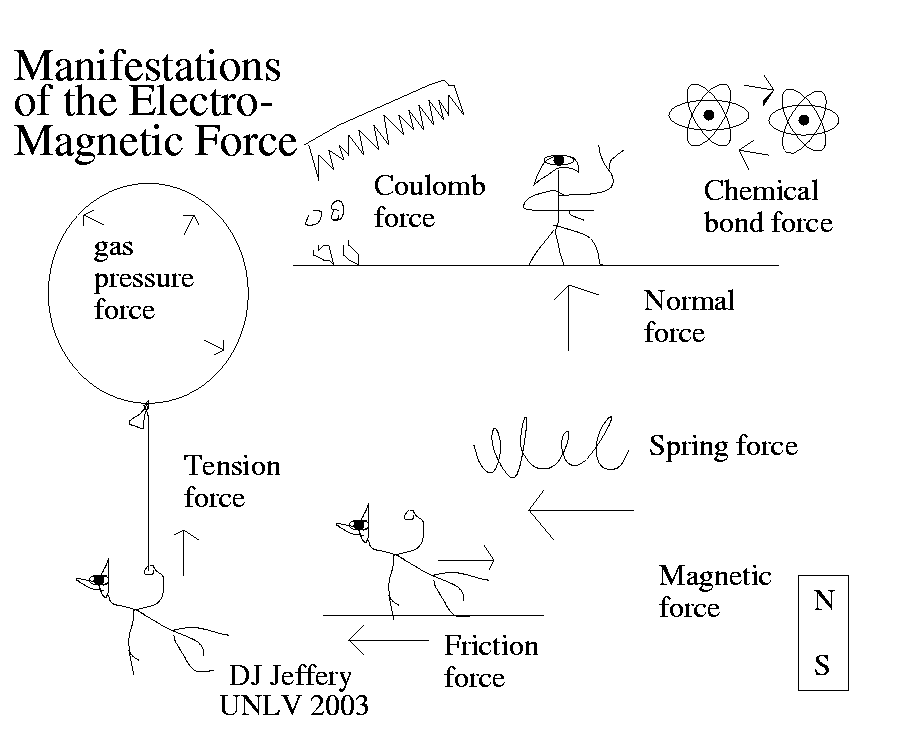
Caption: Illustrations of some manifestations of the electromagnetic force.
Do demonstration with comb and bits of paper and hair-combed comb if possible.
Credit/Permission: © David Jeffery, 2003 / Own work.
Image link: Itself.
Typically when you form from particles or subsystems that are brought in from infinity, you get energy out that typically we don't count as part of the BOUND SYSTEM because often it propagates away somehow.
The subsystems had more energy apart than together.
The energy you get out is often in the form of electromagnetic radiation, heat, and/or kinetic energy.
Since the subsystems had more energy apart than together, they had mass apart than together.
So forming BOUND SYSTEMS from initially far apart subsystems is typically exothermic using the jargon of thermodynamics (heat physics) loosely.
If you transform from kinds of BOUND SYSTEMS, you may get energy more energy out (i.e. have an exothermic transformation) or you may need to put energy in (i.e., have an endothermic transformation).
SYSTEMS become more tightly bound if you get energy out and less tightly bound if you put energy in.
But note exothermic transformations don't necessarily happen spontaneously.
Often you have to overcome an energy threshold before exothermic transformations.
For example, fire.
It's an exothermic chemical reaction.
But fires in everyday life don't start spontaneously.
There has to be an initial heat energy input to overcome a threshold and then the heat energy output from the first reactions propagates the reactions.
Fire is a chain reaction actually, but usually NOT described that way.
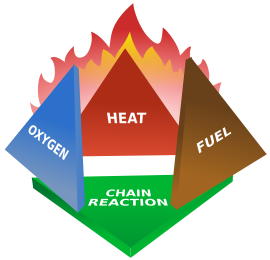
Caption: "The Fire tetrahedron for the article Fire triangle. Created by Gustavb."
Credit/Permission: User:Gustavb, 2006 / Public domain.
Image link: Wikipedia: File:Fire tetrahedron.svg.
We will briefly consider the hierarchy of BOUND SYSTEMS.
- Bound Systems: A First Look:
- Bound Systems
-
Nowadays in standard model of particle physics,
one thinks of the fundamental particles has being quarks
and leptons and the force carrier particles.
See the figure below for some insight.
We'll just sketch how one builds up the world from the fundamental particles.
Quarks in threes make up the protons and neutrons. See the figure below for the proton structure of 3 quarks.
Quarks may be truly point-like---or maybe NOT.

Caption: "The quark structure of the proton. There are two up quark in it and one down quark. The strong force is mediated by gluons (wavey). The strong force has three types of charges, the so-called red, green and the blue. Note, the choice of green for the down quark is arbitrary; the `color charge' is thought of as circulating between the three quarks."
The diagram is meant to be taken only as a symbolical representation: quarks may NOT be really picturable.
Besides up and down quarks, there are 4 other kinds making 6 kinds of quarks in total.
There are also 6 antiquarks too.
The up and down quarks are the ones used in ordinary matter.
The make up protons and neutrons.
A neutron has two down quarks and one up quark.
Credit/Permission: © Arpad Horvath, 2006) (uploaded to Wikipedia by User:Harp, 2006) / CC BY-SA 2.5.
Image link: Wikipedia: File:Quark structure proton.svg.
They can exist in a superdense state called quark-gluon plasma which can be briefly formed in large particle accelerators and exist in some astrophysical environments probably.
Protons and neutrons are BOUND SYSTEMS.
The strong nuclear force binds them.
Protons and neutrons are about 10**(-15) meters in size scale.
The strong nuclear force also binds the protons and neutrons into the atomic nuclei of which there are a large variety.
Atomic nuclei typically have size scales of 10**(-14) meters.
-
The electromagnetic force
tries to push atomic nuclei apart.
But the strong nuclear force prevents this.
But the strong nuclear force is very short range, and so atomic nuclei repel each other unless brought very close together.
The energy to do that is the threshold energy for nuclear reactions.
It's a very large energy and this is why nuclear reactions in bulk are NOT common in the terrestrial environment.
An exception is the radioactive decay of unstable atomic nuclei.
This is a spontaneous reaction that needs no threshold energy.
But radioactive decay only proceeds at characteristic rates determined by the nuclear half-lives.
A half-life is the time it takes for half a sample of a radioactive material that has that half-life to decay---i.e., transform and emit radiation of some kind.
The radiation is made of particles or gamma rays which we will discuss later.
In the figure below is an example of a particular kind of radioactive decay: beta- decay.

Caption: "A diagram showing beta- decay:
n → p+ + e- + electron antineutrino
In false colors, the protons are red and neutrons are blue.'' (Somewhat edited.)In this beta decay process, a neutron in the nucleus decays to a proton, a neutrino (a very low mass, very unreactive particle), and a beta- particle (which just a high velocity electron).
The neutrino and beta- particle are the radiations that escape the nucleus.
In any half-life that characterizes the radioactive nucleus, there is a 50 % chance of the decay occurring.
Credit/Permission: User:Inductiveload, 2007 / Public domain.
Image link: Wikipedia: File:Beta-minus Decay.svg.
Electrons are the most important kind of leptons.
-
The strong nuclear force
does NOT act on leptons.
The periodic table (see figure below) shows the known atoms and atomic nuclei that go with them.
Otherwise it has a positive or negative charge and is called an ion.
Atoms can be bound together to make molecules.
The binding force is again the electromagnetic force, but in a complex manifestation.
Molecules can be immensely complex, but even simple ones can have very complex behavior---like the water molecule---good old H2O.
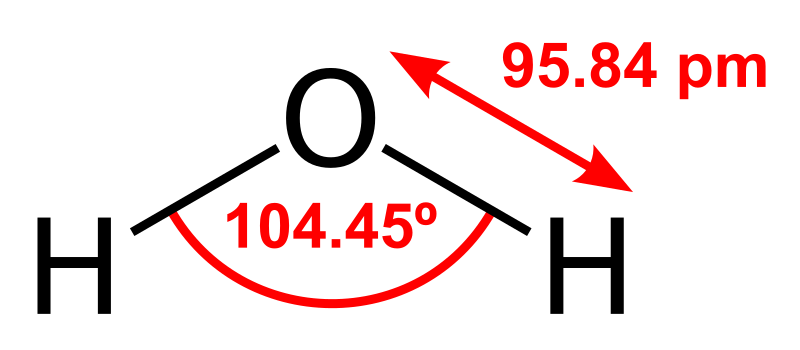
Caption: "Water molecule with bond lengths and angles".
This is just a schematic diagram of course where the letters label the central points of the oxygen atom and the hydrogen atoms.
The "pm" stands for picometer. 1 pm = 10**(-12) m.
95.84 pm = 0.9584 angstroms.
Credit/Permission: © User:Dan Craggs, 2009 (uploaded to Wikipedia by User:AtomCrusher, 2009) / CC BY-SA 1.0.
Image link: Wikipedia: File:H2O 2D labelled.svg.
Atomic nuclei, atoms, and molecules are NOT static structures.
The constituents are partially held up from collapse by kinetic energy and angular momentum.
-
Also partially held up by repulsive forces at short range.
We don't really know how the fundamental particles are held up.
We don't their internal structure by definition as fundamental particles.
Atoms arn't really like little solar systems---although in older science fiction that idea sometimes turned up.
Free atoms and molecules form gases. Bound atoms and molecules form liquids or solids.
In liquids the atoms and molecules though bound freely slide over each other.
In solids, they don't. The atoms and molecules are fairly rigidly bonded.
The binding of liquids or solids is done by the electromagnetic force.
But what does gravity do for the structures we've discussed so far?
Well self-gravity does very little for structures of human-size or even mountain-size or smaller.
All particles of mass---which means all particles of energy---attract all others gravitationally.
There is no anti-gravity so far as we know.
But gravity in a sense is a rather weak force.
It a takes mountain-size object or more for self-gravity to have a significant effect on structure.
Everyone in this room is attracted to everyone else---but so weakly you never notice---good thing to or we could be just a mass of arms and legs.
Now the self-gravity of big objects like the Earth does have an obviously important effect on the Earth's structure as a whole.
And on the little objects on the Earth like us.
The self-gravity doesn't cause the Earth to collapse---to black hole because the pressure force of the atoms
Support by kinetic energy and and angular momentum is NOT very important for the Earth.
There's a small bit of support because the Earth is rotating.
On the other hand, the Solar System, the planetary systems (i.e., other solar systems), the galaxies and the galaxy cluster are supported from collapse by kinetic energy and and angular momentum.
Let's turn our attention to gravity now in a bit of detail.
- Gravity
-
Gravity
is some ways much simpler than the electromagnetic force.
- The resistance to acceleration.
- The source of the gravitational force.
-
Newton's Law of Universal Gravitation:
The Newton's law of universal gravitation which holds between ideal point masses is:
G M_1 M_2 F_12 = ------------------- R_12**2 where G = 6.6742*10**(-11) in MKS units (circa 2002) is the universal constant of gravity. M_1 is the mass of point mass 1. M_2 is the mass of point mass 2. R_12 is the distance between the masses. Notice this distance comes in as an inverse-square. We say that the formula is an inverse-square law and gravity is an inverse-square law force. F_12 is the force that 1 exerts on 2 and the force that 2 exerts on 1. The forces are directly on the line between the two objects and point in opposite directions. The gravitational forces are attractive always. No anti-gravity exists in the ordinary realm of physics, but there may be a cosmological anti-gravity that is discussed in IAL 30: Cosmology. By the way, the MKS unit of force is the newton: N=kg*m/s**2: 1 N = about 1/5 lb. The gravity force law gives force in newtons when MKS units are used consistently.Now POINT MASSES are one of those idealizations that physicists love.
In classical physics they don't exist. They may exist in quantum mechanics. We are NOT sure. In any case, we really don't know how gravity behaves close to quantum mechanical particle. No established quantum theory of gravity exists. The quantum theory of gravity should be part of Theory of Everything or TOE.
But the gravity force law is actually of the great use as we describe in the subsection below.
- Newton's Law of Universal Gravitation is of Great Use:
Newton's law of universal gravitation is actually of the great use.
Firstly:
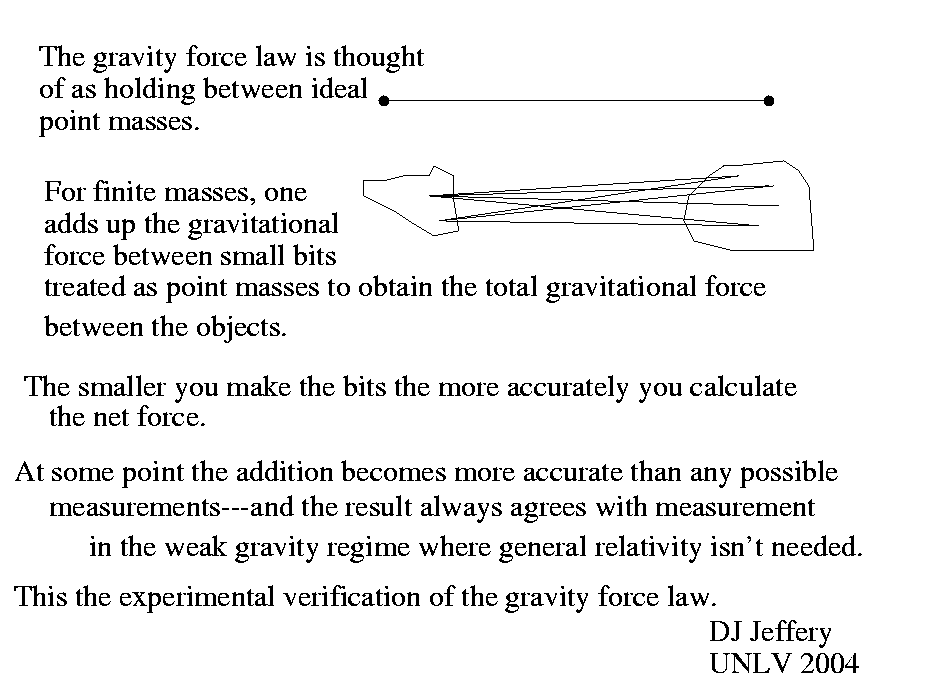
Caption: Gravity between objects of general shape.
Credit/Permission: © David Jeffery, 2004 / Own work.
Image link: Itself.
Secondly:
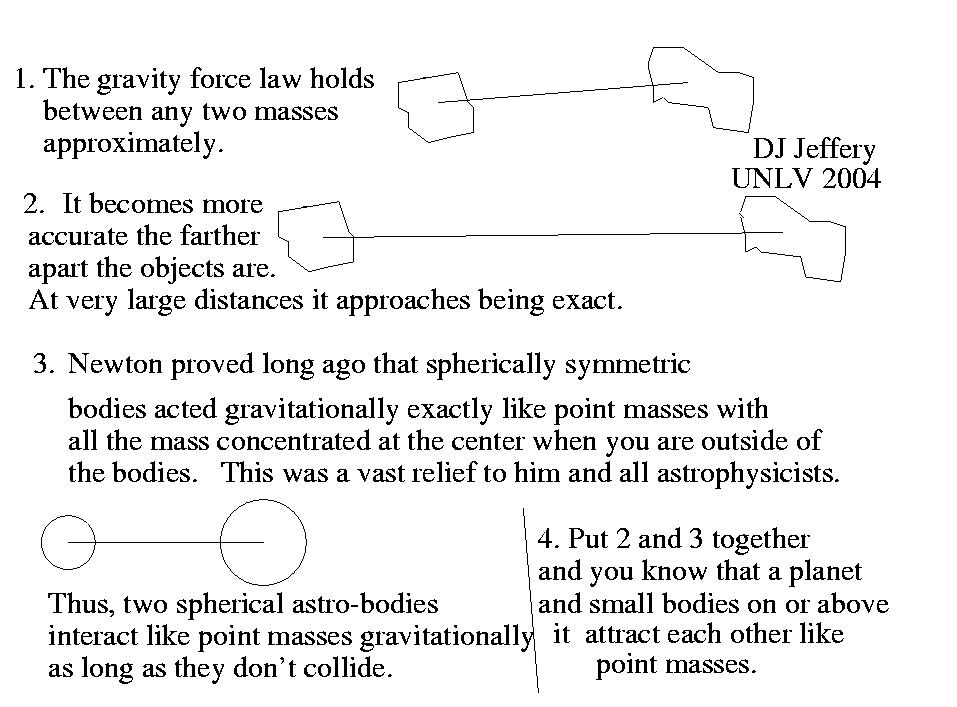
Caption: Gravity between objects with simplifying conditions.
Credit/Permission: © David Jeffery, 2004 / Own work.
Image link: Itself.
- Some Gravity Questions:
What is the gravitational force between two 1-kilogram spherically symmetric masses held 1 meter apart?
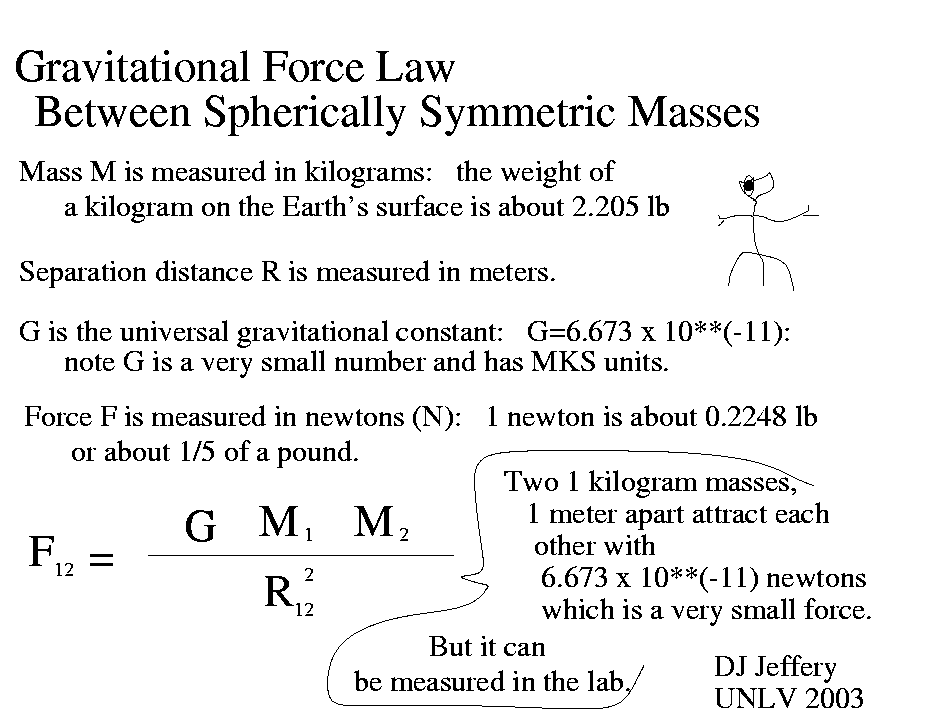
Caption: Gravity is a very weak force as shown by the gravity between two 1-kilogram spherically symmetric masses held 1 meter apart
Credit/Permission: © David Jeffery, 2003 / Own work.
Image link: Itself.
The last figure illustrates that the gravitational force between human size and even much larger objects is usually unnoticeable.
Now recall
G M_1 M_2 F_12 = ------------------- R_12**2-
Question: If we double the distance between two masses, the force:
- drops by a factor of 2.
- increases by a factor of 2.
- drops by a factor of 4.
Answer 3 is right.This behavior is shown in a cartoon in the figure below (local link / general link: function_behaviors_plot.html).
Gravity is much more long range than any contact force.
Question: If we double one mass, the force:
- drops by a factor of 2.
- increases by a factor of 2.
- drops by a factor of 4.
Answer 2 is right.Question: If we double both masses, the force:
- drops by a factor of 2.
- increases by a factor of 2.
- increases by a factor of 4.
Answer 3 is right.Recall all masses attract.
Question: Why don't we in this room feel mutually attracted?
- Gravity repels for small masses.
- Gravity turns off for small masses.
- Gravity is very small for small masses and thus we arn't pulled into a big cluster of arms and legs in the center of the room.
Answer 3 is right.Gravity can actually be measured for human-sized objects, but it takes very sensitive apparatus.
- Newton's Law of Universal Gravitation is of Great Use:
It has only one "charge": MASS.
-
Mass has an odd double function in
Newtonian physics:
This double function is just a coincidence in Newtonian physics.
In general relativity the coincidence is explained---but we will never go into that esoteric point.
Now gravity on Earth was always known. Isaac Newton (1643--1727) did NOT discover that.
What Newton discovered was that gravity is universal: both on Earth and in the astronomical realm, there was gravity obeying the same law. Newton's discovery is illustrated in the figure below (local link / general link: newton_apple.html).
- Gravity Near the Earth's Surface
-
In an absolute sense, gravity
near the Earth's surface is a very
parochial affair, but it's our parish: i.e., where we live.
- The centrifugal force
due to their axial rotation will make planets and stars
oblate (i.e., bulge at the equator).
The centrifugal force is NOT an ordinary force, but the tendency of bodies to move in a straight line. It is the thing that tends to throw you off playground merry-go-rounds. It increases with rotation rate.
This is just one manifestation of rotation helping to hold and determine structure.
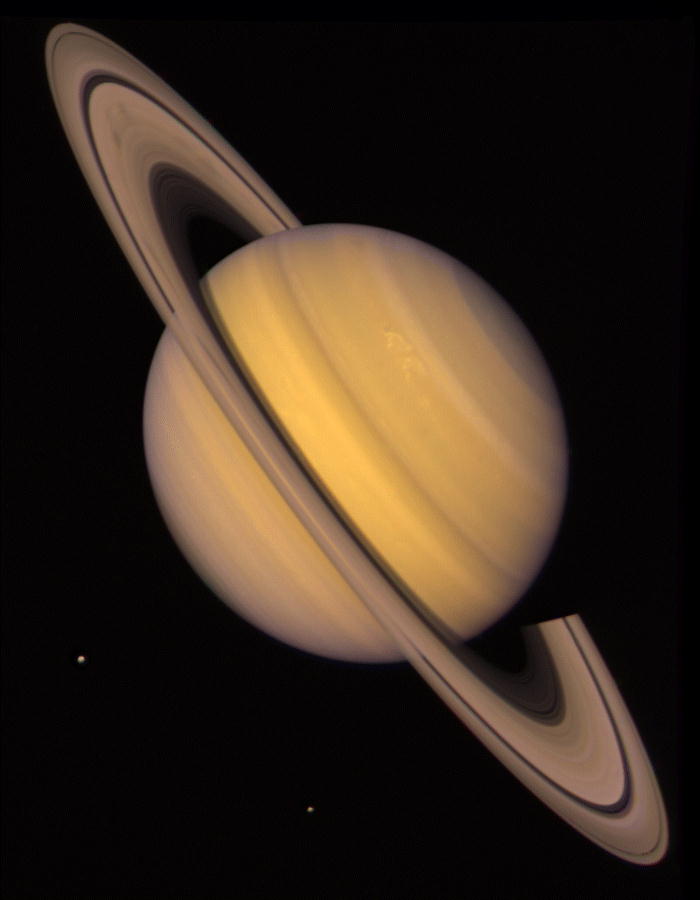
Caption: Saturn ♄, the ringed world. Real color? Two moons are visible.
You note that Saturn is obviously oblate with equatorial diameter (which is parallel to the bands and rings) is about 10 % larger than the polar axial diameter.
The defined oblateness is
(R_equator-R_polar)/R_polar = 0.0979624 ≅ 10 % , where R_equatorial is the equatorial radius and R_polar is the polar radius. (Cox-295).The oblateness is caused by the centrifugal force which is high for Saturn because of its fast rotation.
Saturn's deep interior rotation period relative to the fixed stars (i.e., sidereal rotation period) is 0.44401 days or 10.656 hours (Cox-295).
Credit/Permission: NASA, before or circa 2003 / Public domain.
Image link: Itself.
- The TIDAL FORCE (as we show below) can perturb the overall
shape from an exact sphere into a slightly stretched shape.
For some elucidation, see the three figures below.
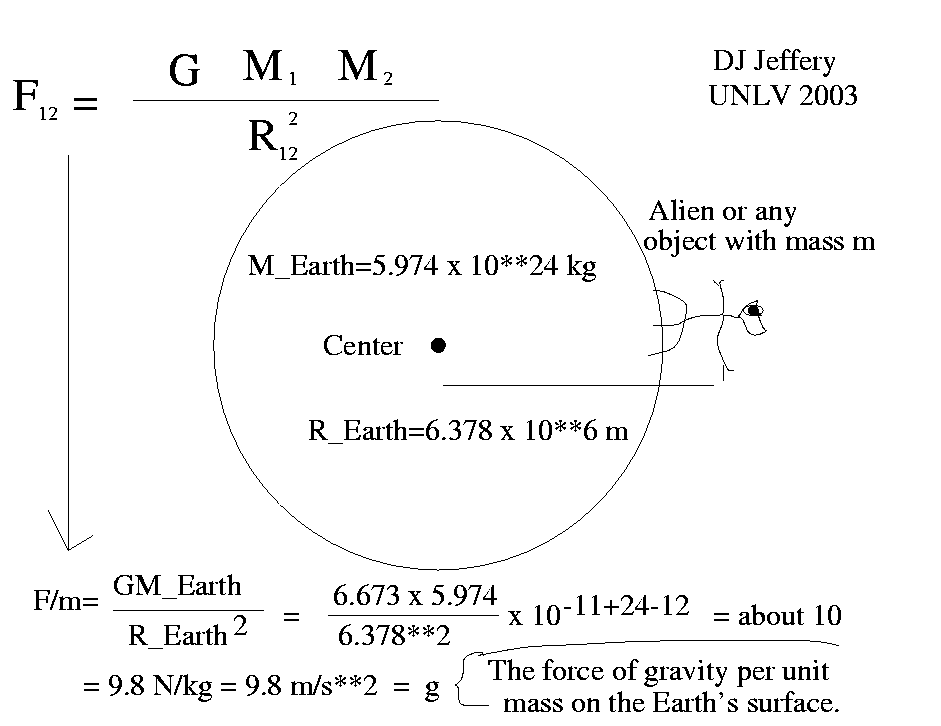
Caption: Gravitation force per unit mass on Earth's surface.
Credit/Permission: © David Jeffery, 2003 / Own work.
Image link: Itself.
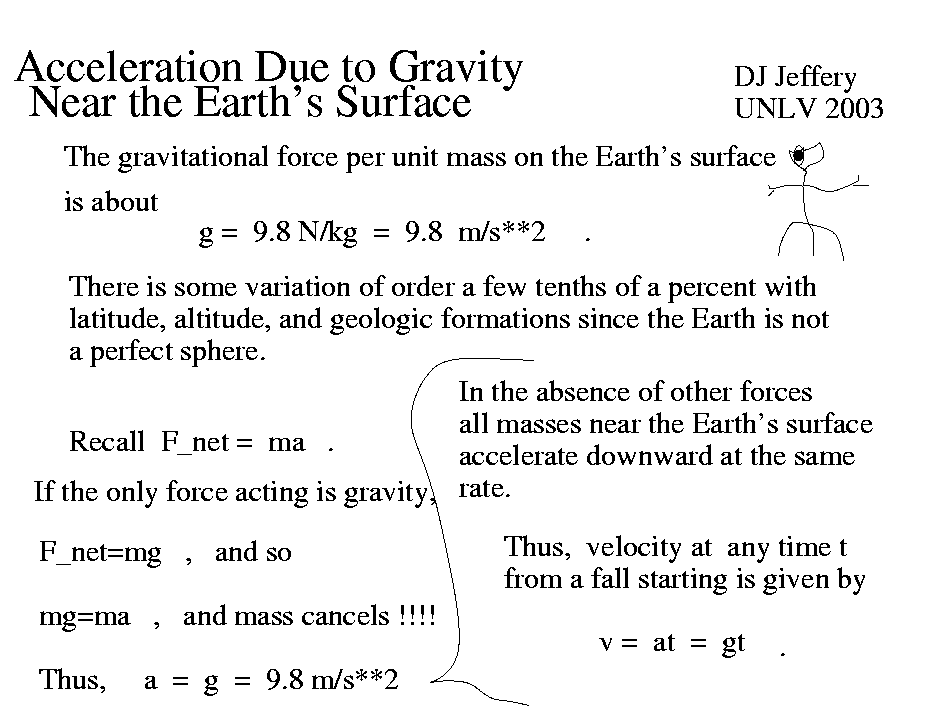
Caption: The acceleration g due to gravity on the Earth's surface.
Credit/Permission: © David Jeffery, 2003 / Own work.
Image link: Itself.
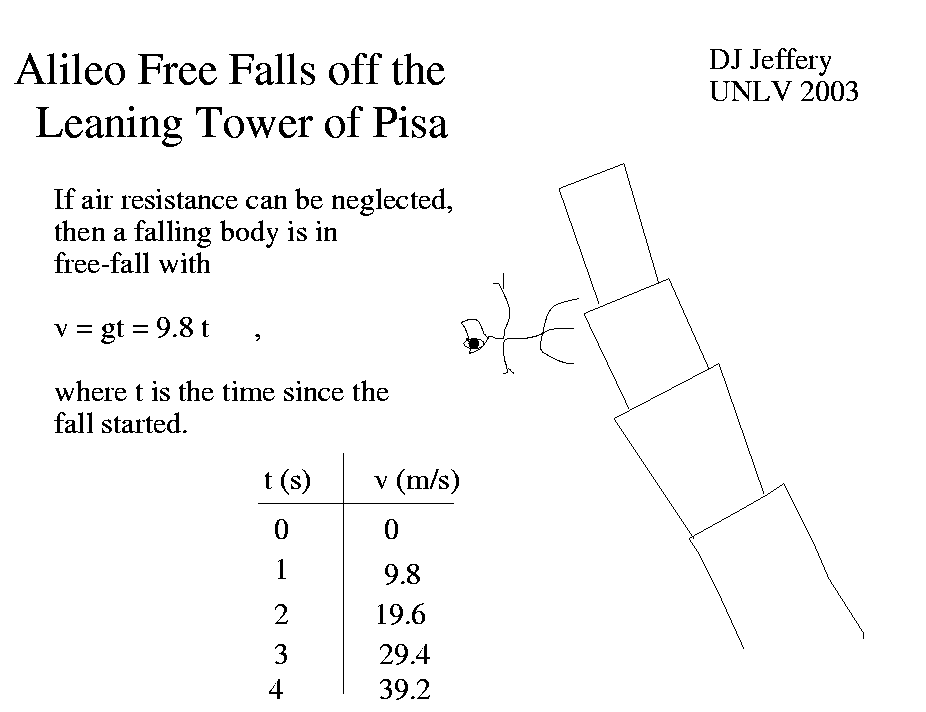
Caption: Accelerating downward under the force of gravity alone.
Credit/Permission: © David Jeffery, 2003 / Own work.
Image link: Itself.
In fact the whole kinematics of falling objects should be the same regardless of mass---if you can neglect air resistance.
Drop a chalk brush and a coin: air resistance relatively small.
Then drop a brush and a sheet of paper: air resistance NOT relatively small for the sheet of paper.
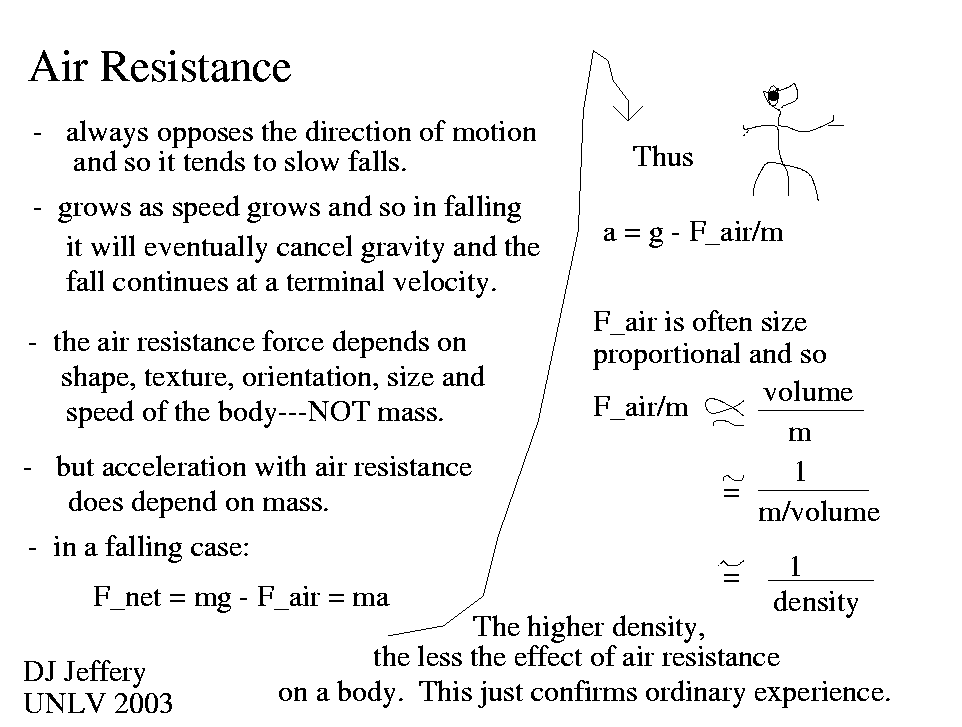
Caption: Air resistance causes falling to reach a terminal velocity.
Credit/Permission: © David Jeffery, 2003 / Own work.
Image link: Itself.
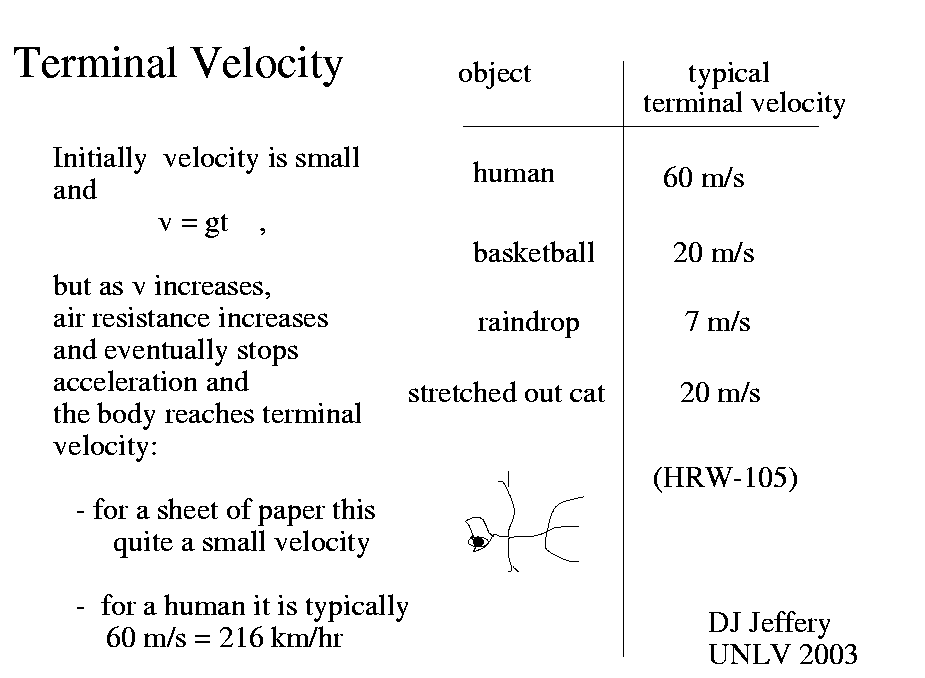
Caption: Examples of terminal velocities. Credit/Permission: © David Jeffery, 2003 / Own work.
Image link: Itself.
In free fall you feel weightless, but this is NOT because gravity has turned off.
Gravity is just pulling you down atom by atom and you arn't resisting, and so there is no internal stress or pressure to resistance.
Standing up and resisting gravity is a different matter. See figure below.
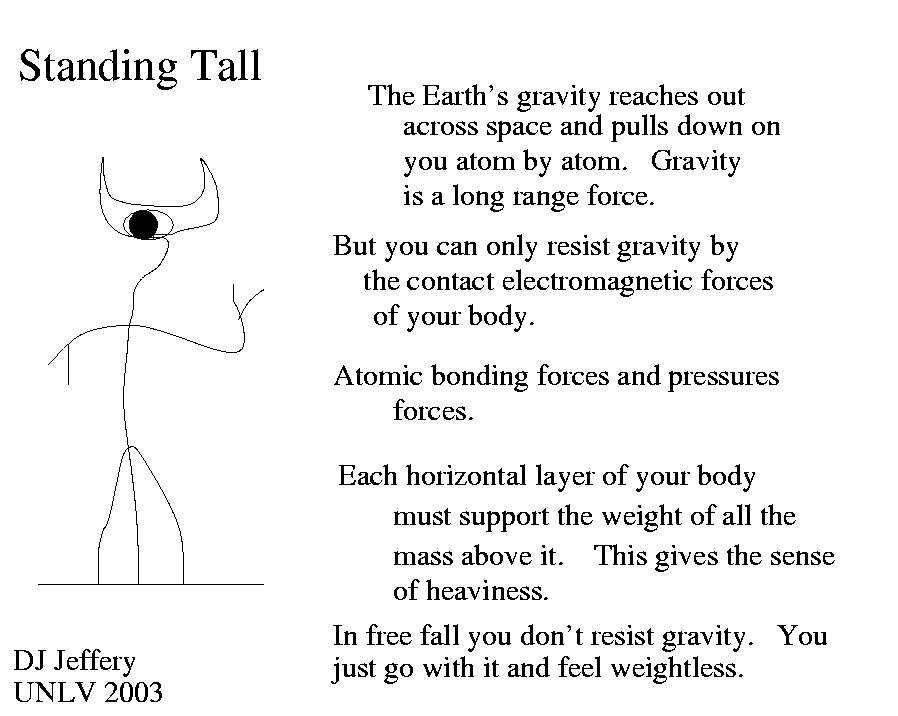
Caption: Standing up and resisting gravity.
Credit/Permission: © David Jeffery, 2003 / Own work. Image link: Itself.
Now NOT only you, but the atmosphere, the oceans, and the solid Earth must stand up under gravity pulling it down.
Only PRESSURE FORCES can withstand the self-gravity of dense, massive bodies like planets and stars.
-
Recall pressure forces are a short-range manifestation of the
electromagnetic force. They are contact forces.
In normal gases (but NOT degenerate gases), they are caused by atoms and molecules bouncing off of one and another: the electromagnetic force is the actual interaction. See the animation in the figure below (local link / general link: gas_animation.html).
The pressure force will NOT provide strength for very complex structures.
For example, water has a strong pressure force: you CANNOT compress it easily.
But water CANNOT resist shearing forces very well: drops can hold a shape, but nothing much bigger.
-
Shear is the sliding of one layer of matter with respect to another.
A shearing force causes shears.
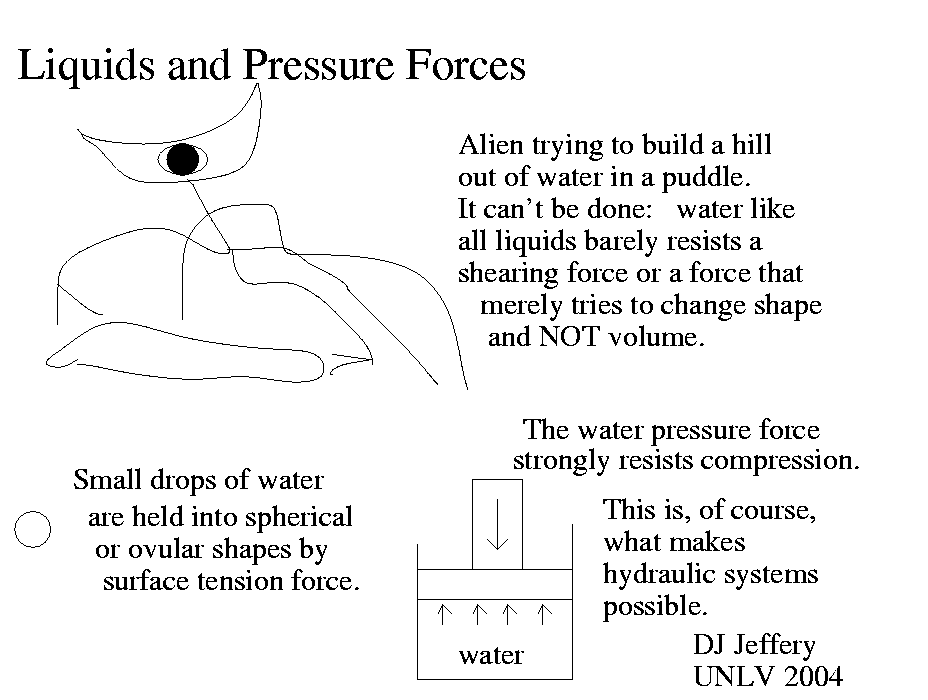
Caption: Liquids and pressure forces.
Credit/Permission: © David Jeffery, 2004 / Own work. Image link: Itself.
Even solids will NOT resist a shearing force if their mass is too big for a shape to be sustained by inter-atomic bonds: i.e., they will act like fluids.
Inter-atomic bonds make a boulder keep its shape under planet-size gravity.
But a boulder as big as a mountain on a planet is flattened into a mountain: i.e., a small protuberance on the face of a planet.
The pressure force can hold up the super-big boulder's mass, but it will push sideways causing the boulder to ``flow'' sideways and slump done to being a mountain.
A boulder as big as a planet in space would be pulled into spherical shape.
-
Its self-gravity tries to collapse it into a point.
The solid pressure resists collapse, but NOT shearing that leads to spherical symmetry.
We see the combined effect of self-gravity and pressure is to produce a body with nearly exact spherical symmetry.
There will be a few low protuberances (i.e., mountains, continents, etc.) and relatively small interior asymmetries due inter-atomic bonds strong enough to resist the relatively low pressures at the base of the protuberances.
There are TWO QUALIFICATIONS:
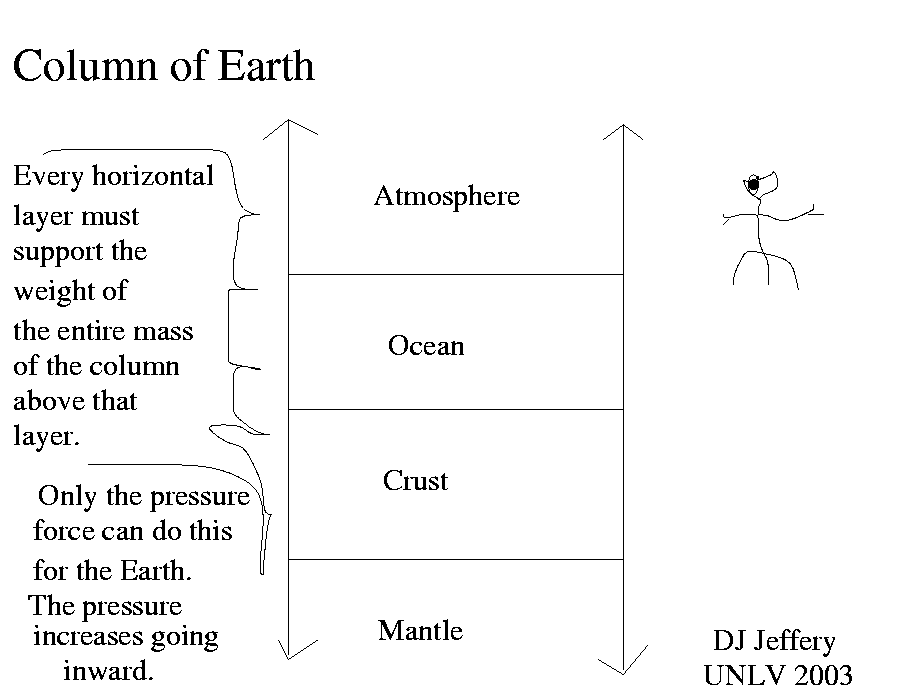
Caption: Earth atmosphere, ocean, crust, mantle, core in a column.
Actually, the columm should be a wedge that narrows to a point at the Earth's center.
Credit/Permission: © David Jeffery, 2003 / Own work. Image link: Itself.
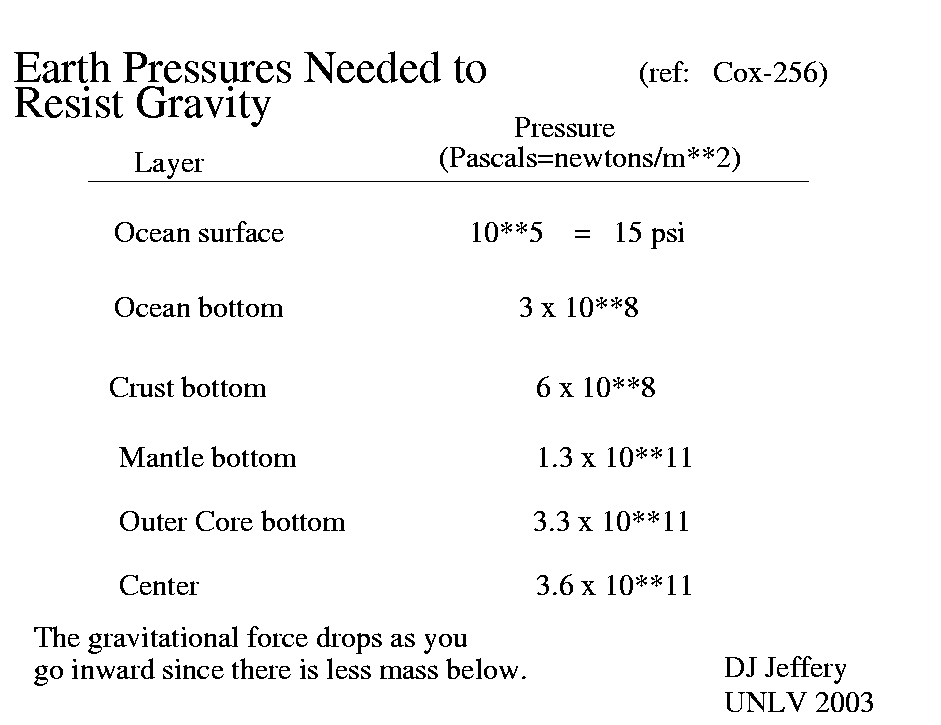
Caption: Pressures at various depths in the Earth.
Credit/Permission: © David Jeffery, 2003 / Own work. Image link: Itself.
Besides pressure, MOTION can withstand strong gravity as we have discussed above. This is what holds up planetary and galactic systems.
The strong self-gravity of these systems is countered by motion.
Usually rotational motion quantified as ANGULAR MOMENTUM or KINETIC ENERGY (i.e., energy of motion which we discuss this below).
ANGULAR MOMENTUM is, loosely speaking, the tendency of rotating bodies to keep rotating.
Let us now move on to gravity in space.
- Circular Orbits
-
One thing to emphasize at the beginning
about circular and other orbits due to
gravity
is that they are quasi-eternal.
- NOT accelerating because its speed is constant.
- accelerating because its direction is changing.
- Yes.
- No.
- it must be circular or the satellite will crash into the Earth.
- it must be highly eccentric or the satellite will crash into the Earth.
- the center of the Earth.
- the center of mass of the Earth-Moon system which is inside the Earth, but well off the Earth's center.
- Gravity reaches across space and pulls on you atom
by atom. If you don't resist gravity at all you are
in free fall and feel weightless. In orbit you are in
perpetual free fall since you are constantly falling.
- The spacecraft walls shield you from gravity.
- The astronaut is tethered to the spacecraft.
- The astronaut is moving in essentially the same orbit as the spacecraft.
They do NOT need extra energy input to keep going. It turns out (and we will NOT prove this) that gravity in pure TWO-BODY SYSTEMS CANNOT cause the orbit to change. Gravitational and other perturbations can to this, but to 1st order the orbit is perpetual.
-
Actually, only in pure Newtonian physics
is the two-body system perpetual.
General relativity tells us that the orbit must decay.
The two-body system loses energy and collapses.
The lost energy escapes as gravitational radiation.
One day, the galaxies may collapse into black holes due to gravitational radiation.
-
Question: In uniform circular motion the orbiting body is:
Answer 2 is right.Velocity is a vector: a quantity with both magnitude and direction.
If either changes, the object accelerates.
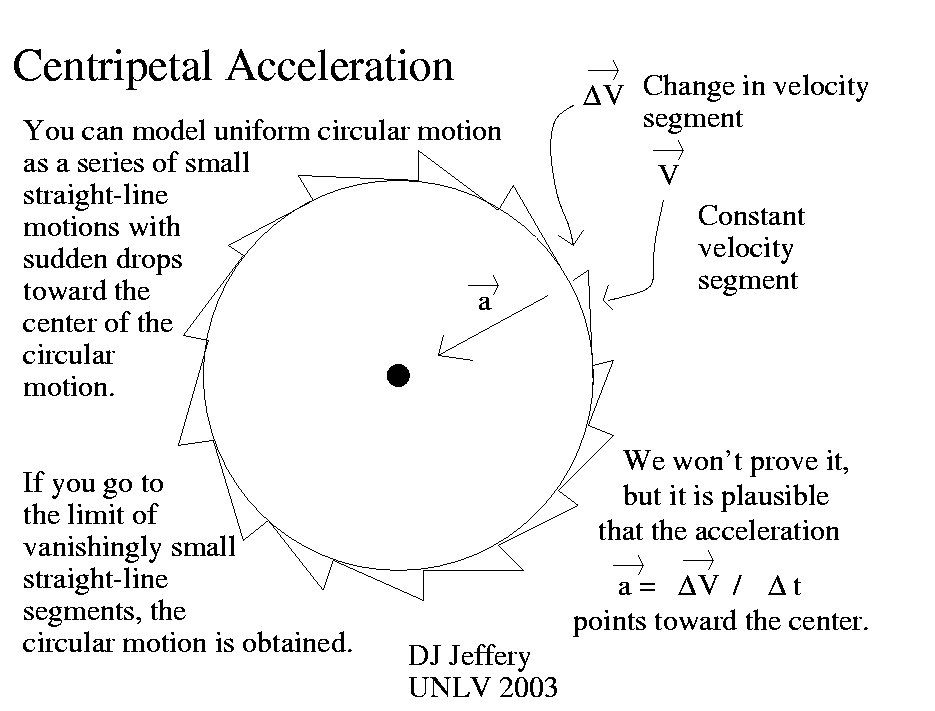
Caption: Acceleration is always toward the center in uniform circular motion.
This center-pointing acceleration has a physics jargon name, centripetal acceleration.
Credit/Permission: © David Jeffery, 2003 / Own work. Image link: Itself.
Consider a slingshot demonstration.
-
The instructor will
now do a slingshot demonstration if he/she has remembered the
equipment. Students in the front row are permitted to cower.
-
Question: An ideal rope is one that only exert a tension
force. Can you push on an ideal rope?
Answer 2 is right.A non-ideal rope can be pushed on a little, of course.
-
This is sort of a backwards argument where a dynamical law has
been used to verify a kinematic result. But at least consistency
is demonstrated.
The figure below (local link / general link: orbit_002_centripetal.png) illustrates centripetal acceleration.
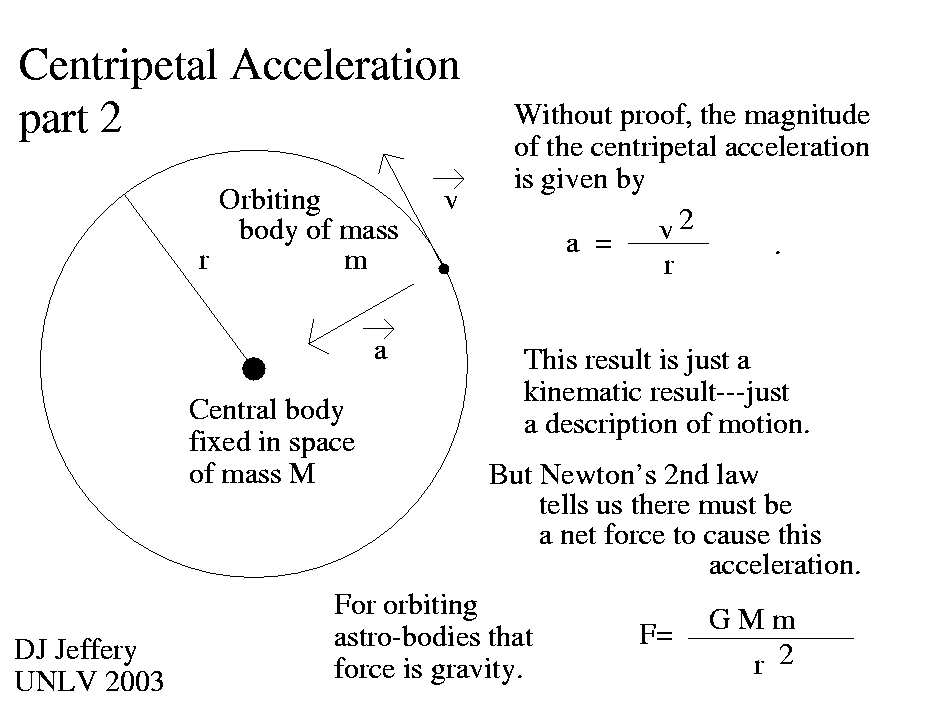
Caption: Centripetal acceleration and its formula a=v**2/r.
Credit/Permission: © David Jeffery, 2003 / Own work. Image link: Itself.
The figure below (local link / general link: ial/ial_005/orbit_003_speed.png) illustrates how to derive the orbital velocity formula from the entripetal acceleration formula a=v**2/r and Newton's law of universal gravitation.
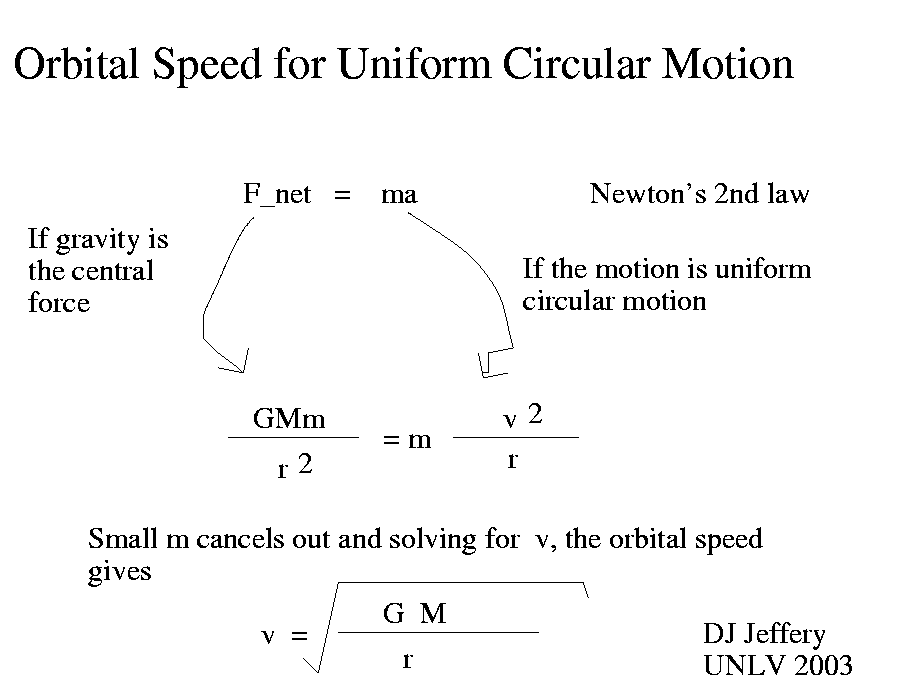
Caption: A derivation of the orbital velocity formula from the entripetal acceleration formula a=v**2/r and Newton's law of universal gravitation.
Credit/Permission: © David Jeffery, 2003 / Own work. Image link: Itself.
Let us now apply our circular orbital speed result to the case of a satellite in LOW-EARTH ORBIT.
-
Question: If an orbit is to be low (i.e., very close to the
Earth) for all of its parts:
Answer 1 is right.-
Question: Small objects orbiting the Earth orbit:
Answer 1 is right.
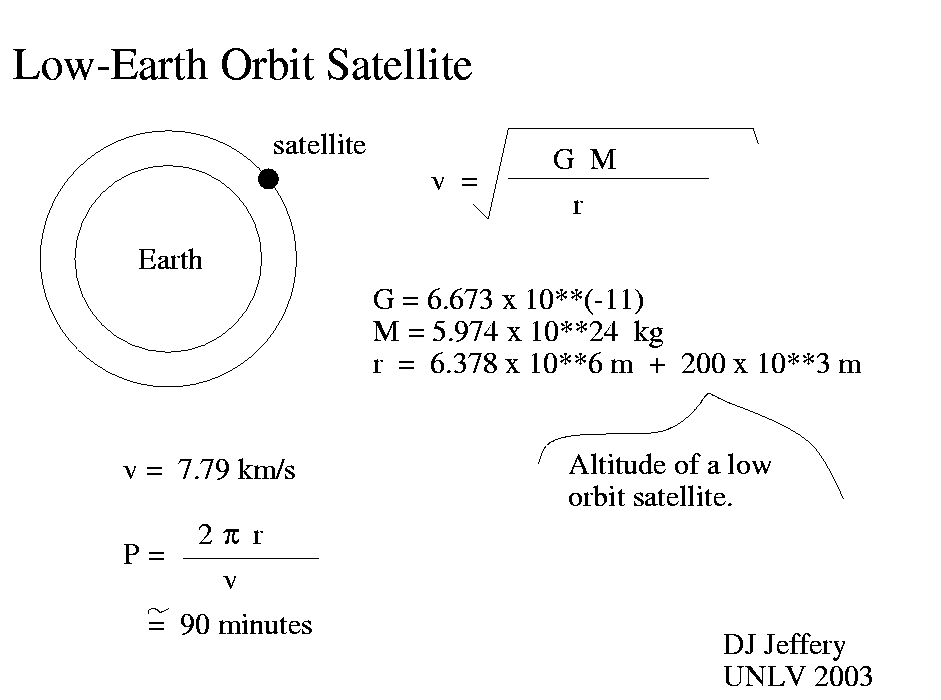
Caption: For low Earth orbit: low-Earth orbital speed and low Earth orbit orbital period.
Credit/Permission: © David Jeffery, 2003 / Own work. Image link: Itself.
A fiducial-value formula for the low Earth orbit orbital period is given in the figure below (local link / general link: gps_global_positioning_system.html).
And note rockets don't need any rocket thrust to do this.
The rocket thrust was needed to give the satellite kinetic energy (energy of motion) to lift it up from the ground and get it moving at about 8 km/s.
Once in orbit the satellite is in a perpetual falling motion.
Quite literally, the satellite and all its contents are falling toward the Earth under gravity---but they keep missing. This fact is illusrated by Newton's cannonball. See the figure below (local link / general link: newton_cannonball.html).
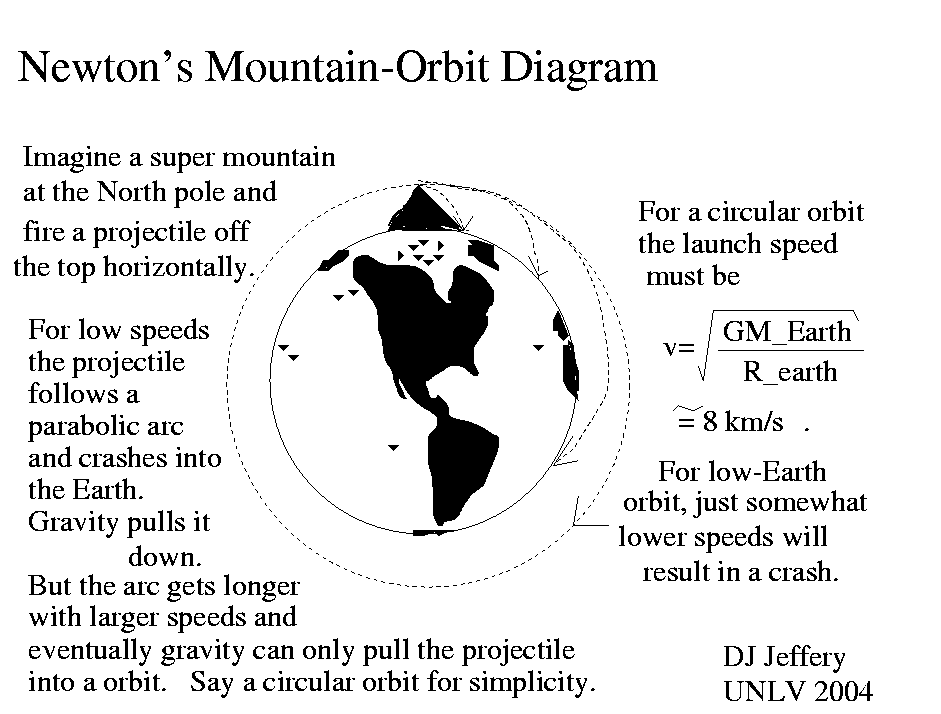
Caption: Newton's cannonball diagram.
Credit/Permission: © David Jeffery, 2004 / Own work. Image link: Itself.
-
Question: The Earth's gravity in low-Earth orbit is
only a little less than on the Earth's surface.
So why are you weightless in orbit?
Answer 1 is right.The longest-answer-is-right rule triumphs again.
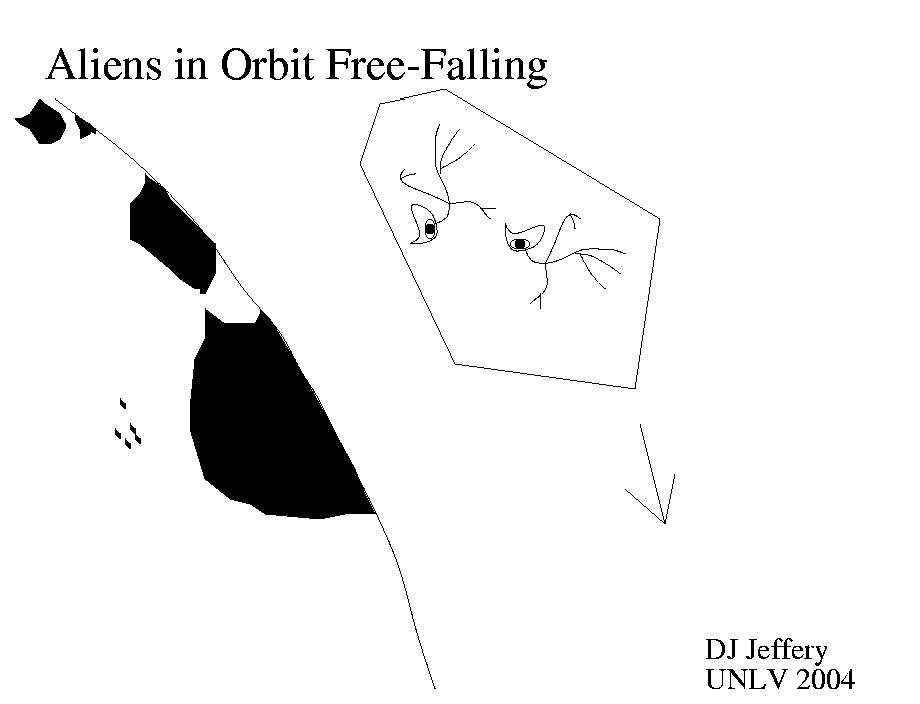
Credit/Permission: © David Jeffery, 2005 / Own work. Image link: Itself.
-
Question: Why can an astronaut go outside the
spacecraft of an EVA (extra-vehicular activity) and
NOT get left way behind by the fast orbiting spacecraft?
Answer 2 is right.Nothing accelerates (or decelerates) the astronaut drastically when he/she goes on an EVA.
Tethering though is essential since small pushes and pulls could sending him/her floating off into slightly different orbits.
-
Air resistance always resists the direction of motion.
The decay accelerates because the lower the orbit, the more the atmospheric resistance.
Most satellites would burn up in the atmosphere: their kinetic energy changing partially into heat energy due to air resistance.
Very large satellites can make it to the ground.
NASA is very concerned about large satellites hitting the ground in an uncontrolled manner.
Usually, they command large satellites to ditch in the ocean.
This may be the fate of the HUBBLE SPACE TELESCOPE!
- Elliptical Orbits, Escape Orbits, and Orbital Pinball
-
Elliptical orbits are non-circular orbits.
- e = 0 for a circular orbit.
- 0 < e < 1 for a closed eccentric orbit.
- e = 1 for a line orbit or, depending on initial conditions, an parabolic escape orbit.
- e > 1 for a hyperbolic escape orbit.
- See Go3-94.
Elliptical orbits are illustrated in the animations in the figure below (local link / general link: orbit_elliptical_explication.html).
The escape orbits are unclosed or OPEN ORBITS. The body travels off to infinity on such an orbit.
What sets the orbit?
Newtonian physics, of course, but that is general and applies to all orbits.
The thing that is particular to individual orbits is INITIAL CONDITIONS.
One way is start the orbit with a small mass a distance R from a large mass.
The large mass becomes the orbit focus or center of force.
The initial speed is v and is perpendicular the radial direction.
The INITIAL CONDITIONS for this setup are R and v.
The two figures below (local link / general link: orbit_launch.html; local link / general link: newton_cannonball.html) illustrate the qualitatively distinct cases that follow from the initial conditions.
But the orbits have since evolved due complex perturbations and collisions.
Space probes have their orbits set by their initial launch and subsequent rocket firings.
That is just a taste of celestial mechanics.
But we can mention the orbital pinball game that space agencies often play.
NASA (or whomever) can use planetary encounters to change probe orbits in useful ways.
The astro-jargon term is gravity assist (AKA gravitational slingshot maneuver). See the figure below for an example of a gravity assist.
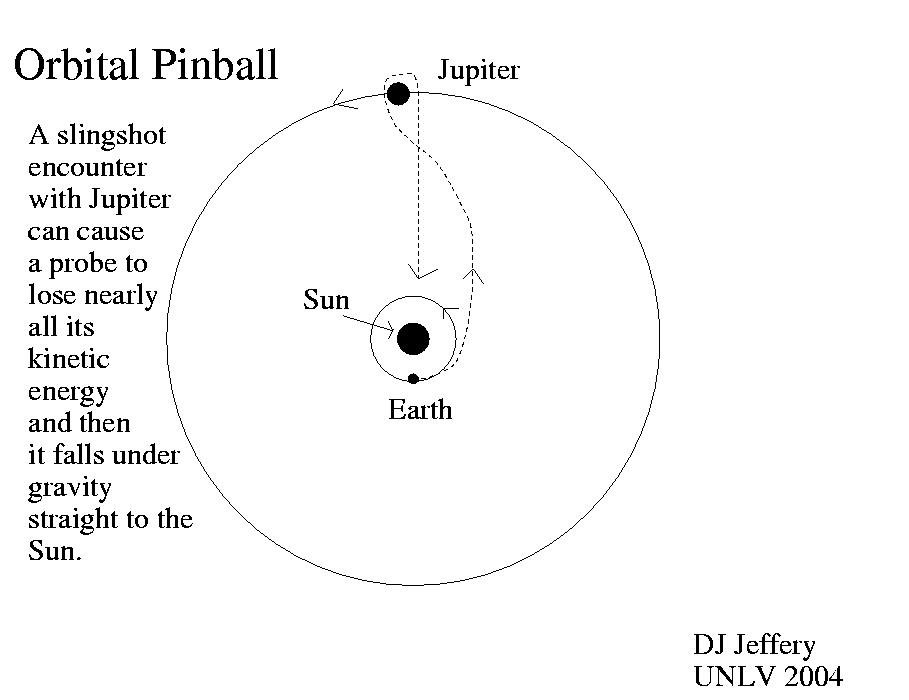
Caption: A schematic diagram of an example gravity assist (AKA gravitational slingshot maneuver) by Jupiter.
To launch a probe straight at the Sun, requires launching it at zero velocity in the frame of the fixed stars
But since the Earth is moving at 30 km/s relative to the fixed stars, the launch speed must be 30 km/s opposite to the Earth. No existing launch vehicle can achieve such a speed.
Instead, the probe can be launched the direction of motion of the Earth.
This gives it a higher orbital speed than the Earth's and sends it on a orbit to the outer solar system.
Then a carefully controlled gravitation encounter with Jupiter (i.e., a gravity assist by Jupiter) slows the probe to zero velocity relative to the fixed stars.
The probe then just falls under gravity toward the Sun.
The procedure, of course, takes years to complete. It takes a long time for the probe to reach Jupiter and return to the inner solar system.
For example, the Ulysses probe was sent into a polar orbit about the Sun after a slingshot maneuver about Jupiter (NASA/JPL Ulysses Site).
In this case the slingshot maneuver wasn't used to stop the probe, but to put it in an orbit that was well out of the ecliptic plane.
It took more than 4 years from launch on 1990oct06 to make its first pass over the Sun's south pole (Ulysses Milestones).
NASA is very clever at slingshot maneuvers---the boys and girls at NASA consider themselves the real pinball wizards.
Credit/Permission: © David Jeffery, 2004 / Own work.
Image link: Itself.
- Thermodynamics
-
Thermodynamics,
like energy, is hard to
define in one-sentence.
- One can say that thermodynamics
is the science of
heat---which properly
should be called
internal energy---but
which in speaking, one seldom does.
Essentially, heat (or internal energy) is the sum of all microscopic forms of energy.
Let's NOT list them. The list is complicated by overlapping categories.
But the key one for thermodynamics is the microscopic kinetic energy: the translational, rotational, and vibrational kinetic energy of microscopic particles. See the figure below for an illustraion of microscopic kinetic energy.
It's the kinetic energy of the random or semi-random microscopic motion of atoms, molecules, electrons, nuclei, photons, and other stuff we won't go into.
The macroscopic manifestations of changes in internal energy are changes in pressure, volume, temperature, and phase of a system---and other things too.
- Temperature is
a bit hard to define too.
A rather general definition is that it is a measure of the average energy per degree of freedom of the particles in a system.
More intelligibly, it's a measure of average microscopic kinetic energy of particles.
The higher the temperature, the more the particles are jostling.
This increases pressure in gases which may cause the gas to increase in volume depending on how it is contained.
Pressure is force per unit area on any surface in a medium. In a gas faster the particles, the harder the particles hit, the more pressure.
In solids and liquids, higher temperature usually---but NOT always---causes bonds to to lengthen which means there is a macroscopic increase in volume and decrease in density. This is called thermal expansion.
In fact, we typically measure temperature by measuring pressure or volume of some substance and having a correlation table of those quantities with temperature: e.g., the scale on a temperature.
There are other ways to measure temperature.
And, of course, we humans are sensitive to temperature and can measure semi-quantitatively just by feel.
-
There is an absolute zero.
It occurs when all the microscopic kinetic energy that can be removed from a system has been removed.
There is actually zero-point energy that CANNOT be removed from particles as dictated by quantum mechanics
On the Kelvin scale, absolute zero is 0 K.
On the Celsius scale, it's -273.15°C.
On the Fahrenheit scale, no one cares.
Practically speaking, it seems impossible for macrscopic system to reach absolute zero, but microscopic systems can easily---but some folks say that doesn't count since temperature is defined to be a macroscopic average.
- Heat can flow between
macroscopic systems.
The main mechanisms at our level are:
- Conduction:
This is one particle colliding with or shaking another neighboring one resulting
in a transfer of microscopic kinetic energy.
We don't see conduction with our eyes, but you can sure feel it happening when you touch something hot or cold.
- Convection: This is
actually, a macroscopic process.
Macroscopic clumps of fluid (gas or liquid) transport heat energy from where the clump formed to where it breaks up.
Convection happens in gravitational fields.
A heated clump expands, becomes less dense, and buoyancy causes it to rise.
Buoyancy is essentially the pressure force.
If a clump's density goes down, net pressure force on the clump increases (because it has more surface area), but its mass and weight don't, and so the gravity force is NO longer balanced.
The clump is pushed opposite to the gravity force direction.
Cold clumps sink to fill the space left by the rising hot clumps.
Convection goes on everywhere on all kinds of scales.
You see it in a boiling pot of water.
It's major flow in the Earth's atmosphere, but it's NOT usually visible since air is invisible.
Even the solid Earth flows on long time scales.
This is the convection in the Earth's mantle that drives plate tectonics. See the figure below.
- Radiative Transfer: All bodies above absolute zero radiate electromagnetic radiation.
We won't go into why.
But this is NOT reflected electromagnetic radiation.
It comes at the expense of the internal energy and has a special distribution with wavelength, that we'll discuss in a later lecture.
- Radiative Transfer: All bodies above absolute zero radiate electromagnetic radiation.
- Conduction:
This is one particle colliding with or shaking another neighboring one resulting
in a transfer of microscopic kinetic energy.
- If two systems are at the same temperature
heat will NOT flow between them when they are in thermal contact.
Thermal contact means the heat transfer processes can operate.
The two systems are said to be thermodynamic equilibrium if heat won't flow during thermal contact---so they are in thermodynamic equilibrium if they are at the same temperature.
Here's a question for the class.
-
Question: When objects of different temperature are in thermal
contact (but CANNOT exchange particles), heat energy always
flows spontaneously:
- from cold to hot objects.
- from hot to cold objects.
- never.
Answer 2 is right.This is one of the simplest of all everyday observations.
In a physics sense, it follows from 2nd law of thermodynamics---which we won't discuss here---we do just below in section The 2nd Law of Thermodynamics.
One can, of course, make heat flow the other way by doing work---Las Vegas would NOT exist without air conditioning.
-
Question: The observable universe is:
- in thermodynamic equilibrium.
- in a extreme state of non-thermodynamic equilibrium.
Answer 2 is right.You can see the electromagnetic radiation streaming out from and nothing much seems to be returning.
Stars are very hot and space if very cold.
The interior temperature of stars is millions of degrees Kelvin.
The dominant energy component of Space actually does have a temperature.
It is the temperature of the cosmic microwave background (CMB) which is thermal electromagnetic radiation left over from the Big Bang.
The temperature of the CMB is 2.725 K (i.e., 2.725 K above absolute zero).
We discuss the CMB IAL 30: Cosmology.
Other gas, dust, and radiation fields in space can have higher temperatures, but the CMB is the main component of space.
-
Systems in thermodynamic equilibrium
to NOT change thermally or macroscopically.
Thermodynamic equilibrium is, in fact, a timeless and lifeless state.
Timeless at the macroscopic level: at the microscopic level atoms are always moving about and changing their microscopic state.
Life as we know it could NOT live in a universe in thermodynamic equilibrium
We need to live in an open system (which is the biosphere of the Earth) with steady inflow and outflow of energy across a temperature gradient.
-
Almost all our energy ultimately comes from the Sun.
- Food energy and wood fuel from photosynthesis.
- Hydroelectricity is comes from the hydrological cycle which
is driven by solar heat.
- Fossil fuels (i.e., coal, oil, and natural gas) are derived from plant
material laid down in the geological past.
- Direct solar power, of course, from photovoltaic cells.
The nuclear bond energy in atomic nuclei created either in other stars or in the Big Bang.
Geothermal power is based on residual/radioactive heat from the Earth's interior. It drives much of geology (e.g., plate tectonics, earthquakes, and volcanoes), but as a direct energy source for society is very minor and unlikely to increase much in importance.
- Food energy and wood fuel from photosynthesis.
- The 2nd Law of Thermodynamics
-
Why does heat flow spontaneously from hot (i.e., high temperature systems) to cold
(i.e., low temperature systems) (at least as long as there are no particle flows)?
- Say you have two samples of different gases in a container separated by a partition.
This is a relatively ordered, low entropy state.
If the partition were removed, the gases would spontaneously mix.
Their random microscopic motions would cause them to diffuse through each other.
When thoroughly homogeneously mixed the gases would have reached maximum entropy for the container system.
Being mixed is more disordered than being unmixed.
The gases will never be seen to spontaneously unmix although energetically nothing forbids that.
The will never be seen to go back to be ordered even though in principle there is some minute probability that they will.
- Say you have a gas in container that initially is all in one corner.
It will diffuse and spread out and never return to being all clumped in one corner.
Being spread is more disordered than being clumped.
So the system spontaneously goes to maximum entropy.
It will never spontaneously reorder even though energetically it could.
You could compress it back into a corner, but that takes extra energy.
- Say you have two systems at different temperature.
Each is initially in thermodynamic equilibrium separately.
Put them into thermal contact and there will be a spontaneous heat flow from hot to cold.
One can see this just the interchange of thermal energy during microscopic interactions as being an averaging process usually rather than the reverse.
When a new overall thermodynamic equilibrium is reached, the entropy of the combined system will have increased
The entropy formula would show this.
We now understand this universal observation as a consequence of the 2nd law of thermodynamics.
-
The entropy of a closed system will always
increase until it is a maximum possible for that system.
The maximum entropy state is the state of thermodynamic equilibrium where all parts of the system are at one temperature.
-
We don't want to go into mathematical formulae for
entropy nor try to be precise
about the exact physical meaning of entropy.
A three of examples help to illustrate what we mean.
There are an enormous number of microstates in which a closed system can find itself consistent with conservation of energy.
An axiom of thermodynamics is that they are all equally likely.
The random microscopic interactions lead to this axiom.
The number of macrostates are much fewer.
There is a many-to-one correspondance of microstates to each macrostate.
The macrostate with the most corresponding microstates is the one most likely to be observed: i.e., it is the most probably macrostate.
So one sees the most probable macrostate or something very close to it.
There are more ways for a system to be disordered than ordered, and so the macrostates that are maximally disordered are favored: i.e., the maximum entropy macrostates.
Just think of your living room.
It's ordered because you've ordered it---one hopes---you're NOT living squalor, right? See figure below for utter squalor.
Caption: "Active tipping area of an operating landfill in Perth, Western Australia. 17 November 2006."
Credit/Permission: Ashley Felton (AKA User:Ropable), 2006 / Public domain.
Image link: Wikipedia: File:Landfill face.JPG.

Caption: "One of several tornadoes observed by the en:VORTEX-99 team on May 3 1999, in central Oklahoma. Note, the tube-like condensation funnel, attached to the rotating cloud base, surrounded by a translucent dust cloud."
Tornados are NOT completely random, but their effects on your living room are rather random.
Credit/Permission: Daphne Zaras, 1999 (uploaded to Wikipedia by User:Yonidebest, 2007) / Public domain.
Image link: Wikipedia: File:Dszpics1.jpg.
It could but it's just so unlikely.
Heat flowing from cold to hot spontaneously has some miniscule probability of happening in principle, but you never ever see it in reality.
It's just so unlikely that random processes will result in ordering the energy in that way.
So the 2nd law of thermodynamics gives a direction to thermal processes---it's sometimes called the arrow of time---like on a one-way street.
So the 2nd law of thermodynamics tends to disorder things.
But there are ordering processes too.
Gravity by trying to clump matter gives an apparent ordering on a big scale.
And yes it does increase order---but only in some places.
You create ordered clumps of matter, but energy is emitted as heat or light and spreads throughout space. Overall disorder increases.
So even gravity seems to bow to the 2nd law of thermodynamics.
-
Actually even the clumped up order of imposed by gravity
can be overcome on a long enough time scale.
But let's NOT go there now.
Evolution too results some pretty high states of order---life. Overall disorder increases.
- Universal Evolution
-
If you have a physical system at some
instant in time and specify all it's conditions, physics
dictates how the physical system
will evolve.
One billard ball hits another or one gas molecule hits another and everything plays out.
-
Thermodynamic equilibrium is
always stable I believe.
We obviously don't live in such a universe.
As discussed in the section Thermodynamics, the universe is profoundly NOT in thermodynamic equilibrium.
It's NOT in macroscopic equilibrium either as we'll discuss in IAL 30: Cosmology.
It's an evolving universe.
In Big Bang theory, the Big Bang was itself the initial condition of the universe and everything evolves from that.
The tendency of macroscopic energy forms to dissipate as waste heat and of physical systems to evolve to thermodynamic equilibrium suggests that thermodynamic equilibrium will be the fate of the universe will.
A lifeless state of thermodynamic equilibrium.
This happy state of affairs is called the heat death of the universe.
- Tides (Not Required for the RHST)
-
The tides
(meaning
ocean tides
on Earth)
are an important application of the
physics we've been
learning as well as being relevant in understanding the
Earth
as planet.
- The
solid Earth tide
is the tidal behavior of the
solid Earth
(in contrast to the tidal behavior of the
Earth's hydrosphere
and Earth's atmosphere).
It has an amplitude of order a meter
with its dominant period being 12.421 h
(Wikipedia: Earth tide:
Tidal constituents).
On the human scale, we never notice
the solid Earth tide
and it's relation to the
ocean tide is complex
(see Wikipedia:
Earth tide:
Other Earth tide contributors) and will NOT go into it.
- The atmospheric tide which is in many ways analogous to the ocean tide, but probably does NOT directly interact with it much.
- Question for Landlubbers:
Let's see how many landlubbers we have.
-
Question: Usually, but NOT invariably, there is/are:
- one high tide per day.
- two high tides per day.
- four high tides per day.
Answer 2 is right.Tide behavior is pretty variable: 1 and 4 high tide situations do happen in confined inlets of oceans at certain times (CW-385).
- Illustrations of the Tides:
The three figures below illustrate the tides in action.

Caption: The intertidal zone at low tide.
The parallel ripples form perpendicular to the tide flow.
Credit/Permission: National Oceanic and Atmospheric Administration (NOAA), David Sinson, NOAA, Office of Coast Survey, before or circa 2003 / Public domain.
Download site: NOAA: Image ID: line1725, America's Coastlines Collection, dead link.
Image link: Itself.

Caption: Wetlands with tidal streams in South Carolina, 1991.
Yours truly guesses this is closer to high tide than to low tide. But yours truly knows little about it.
Credit/Permission: National Oceanic and Atmospheric Administration (NOAA), Richard B. Mieremet, Senior Advisor, NOAA OSDIA, before or circa 2003 / Public domain.
Download site: Image ID: line0095, America's Coastlines Collection. Alas, dead link.
Image link: Itself.

Caption: Near the lower Patuxent River, Maryland during an extreme high tide.
You can see the high tide is running up a country lane of some kind. This is just off Chesapeake Bay where there is considerable land subsidence.
Part of the problem is that if you pump fresh water out of the ground, you lower the water water table and land subsidence follows. This is a problem NOT unknown in Las Vegas, Nevada
Flooding like this could become very common with sea level rise due to global warming.
Credit/Permission: National Oceanic and Atmospheric Administration (NOAA), Mary Hollinger, NODC biologist, NOAA, before or circa 2003 / Public domain.
Download site: Image ID: line0647, America's Coastlines Collection, dead link.
Image link: Itself.
A nautical chart showing the intertidal zone of East Friesland is given in the figure below (local link / general link: riddle_of_sands_map_b.html).
- The Causes of the Tides on the Earth:
The tides (i.e., the ocean tides) on Earth are caused by the tidal force of the MOON and secondarily to the SUN.
Let's just consider the MOON alone first and worry about adding the effect of the SUN later.
-
This the way (the tao) of physics and astronomy (and many other
sciences too)---isolate
the most important effect, understand it, and
then add the other complications
on as perturbations to end up back with messy reality.
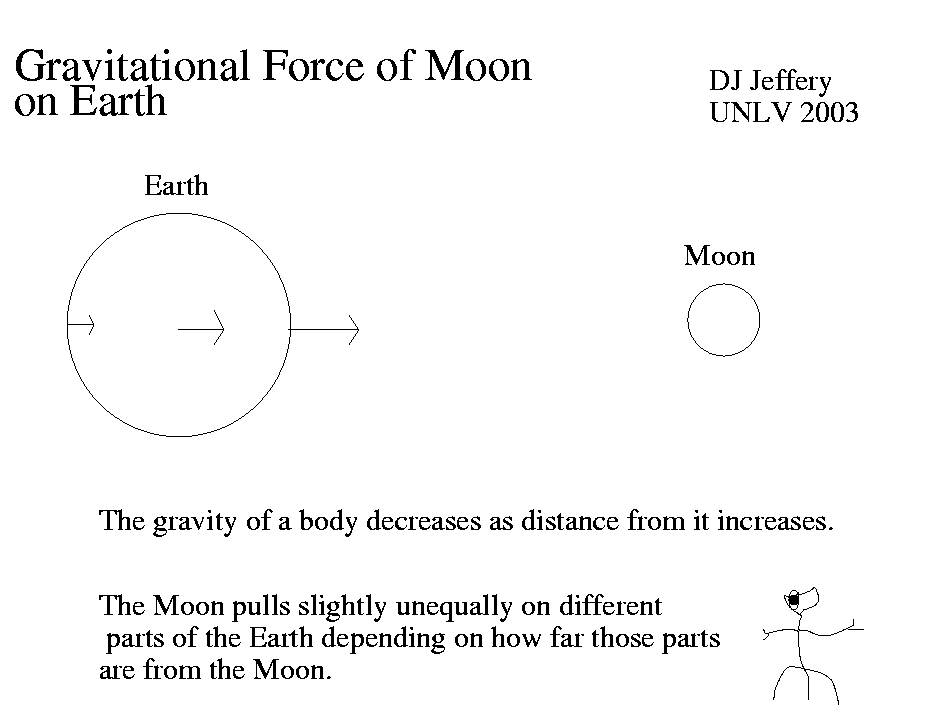
Caption: The gravitational force and the tidal force of the Moon on the Earth.
Credit/Permission: © David Jeffery, 2003 / Own work.
Image link: Itself.
The tidal force is rather fully explicated in the figure below (local link / general link: tidal_force.html).
But the Moon's tidal force is only part of the story.
There is another part.
The Earth constitutes what yours truly calls a center-of-mass (CM) inertial frame: i.e., its center of mass is in free fall under the net external gravitational field of the rest of the observable universe---but the key components of that for determining its local motion are the gravitational fields of Sun and Moon.
At the very local level, the Earth orbits the center of mass of the Earth-Moon system as illustrated in the figure below.
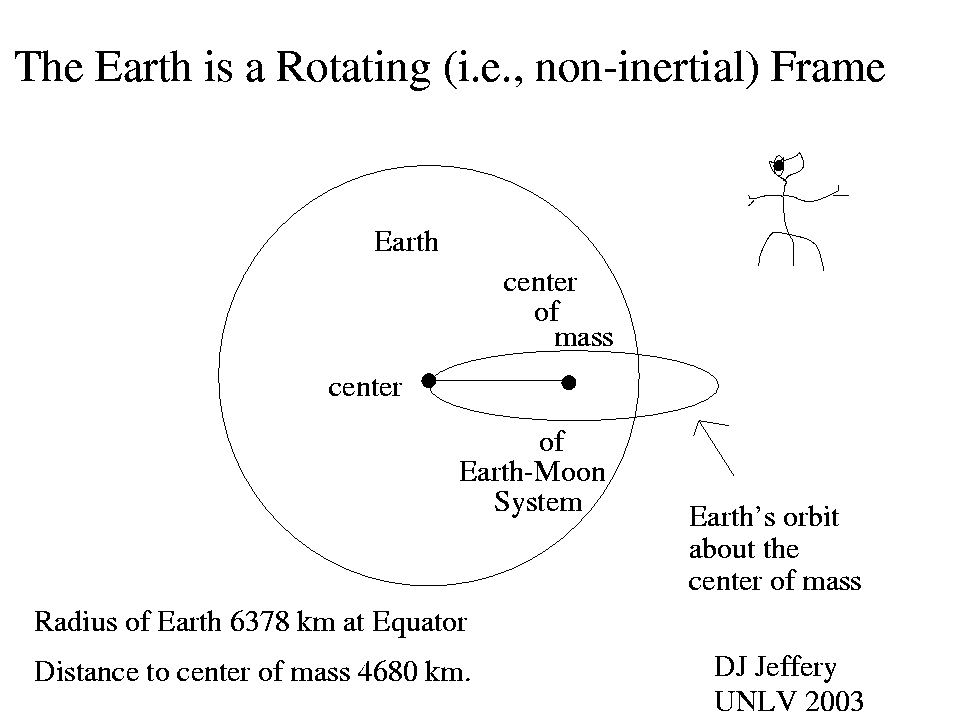
Caption: The Earth (more specifically its center of mass) in orbit around the center of mass of the Earth-Moon system.
Credit/Permission: © David Jeffery, 2003 / Own work.
Image link: Itself.
- The Explication of the Tides:
The full explication of the tides in the ideal case is given in mechanics/tide_ideal.html, but this is mostly beyond the scope of IAL.
Here we give the short, qualitative explication.
First note that the force per unit mass due to the Earth's own gravity is the Earth's gravitational field strength g = 9.8 N/kg = 9.8 m/s**2 (fiducial value).
The tidal force is about 10**(-7) times smaller than g = 9.8 N/kg (Fre-532).
So humans never notice the tidal force directly: you just do NOT notice such small variations in the effective force of gravity you are subject to as Earth rotates in the course of a day.
On the other hand, the oceans (or the World Ocean) notice it minutely.
But a minute effect on the big oceans is big by human scale: e.g., a small ripple to it becomes a tsunami to us.
Thousands of kilometers across and several kilometers deep, a change in sea level by a meter or so to adjust for the tidal force is NOT very big relatively speaking.
The adjustment changes the Earth's gravity on the oceans and changes the water pressure in the oceans.
The adjustment creates the tidal bulges which are illustrated in the figure below.
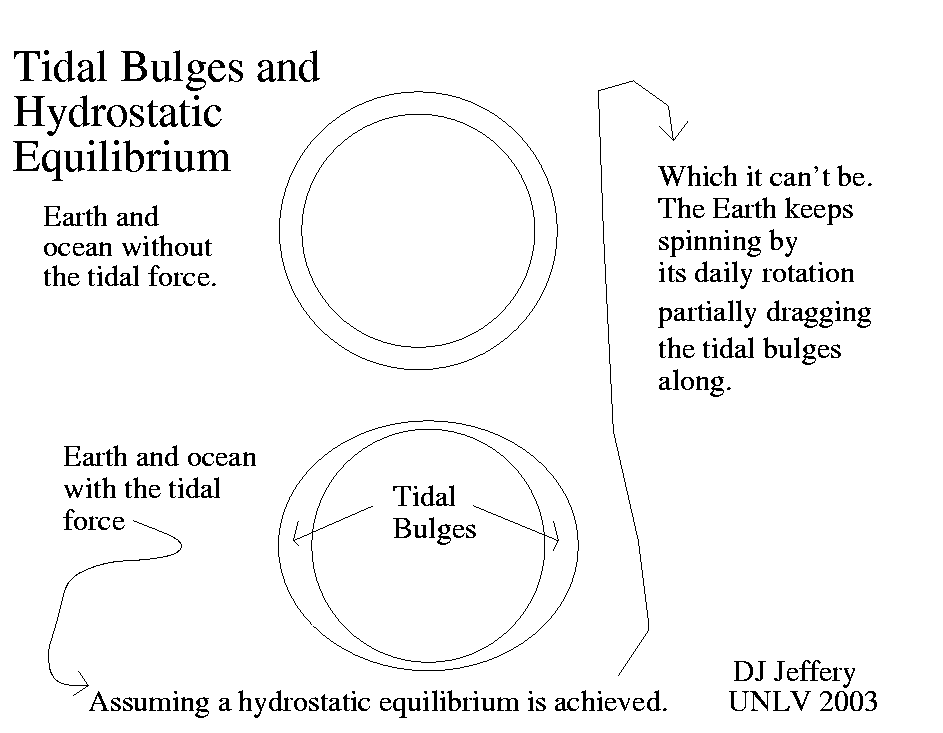
Caption: The ideal World Ocean that covers the whole ideal spherical Earth
Without the tidal force the ideal World Ocean has equal depth everywhere. This is hydrostatic equilibrium, situcation.
With the tidal force, tidal bulges form.
Actual tidal bulges never come into exact hydrostatic equilibrium because the tidal force rotates observable universe.
Credit/Permission: © David Jeffery, 2003 / Own work.
Image link: Itself.
If the oceans were allowed to come into HYDROSTATIC EQUILIBRIUM in the rotating frame of the Earth around the Earth-Moon center of mass, there would be permanent bulges.
This is just the adjustment of gravitational, tidal, and water pressure forces so the net force at every point is ZERO.
The reality is that HYDROSTATIC EQUILIBRIUM can never be established because of the Earth's rotation on its axis.
In the figure below, we take a north pole view and for simplicity assume the Moon's orbits in the Earth's equatorial plane.
Actually, the Moon's orbit is tilted from the equatorial plane by an amount varying between 18.5 degrees and 28.5 degrees????: the variation is caused by that pesky rotation of the notes we discussed in IAL 3: The Moon: Orbit, Phases, and Eclipses. See the figure below.
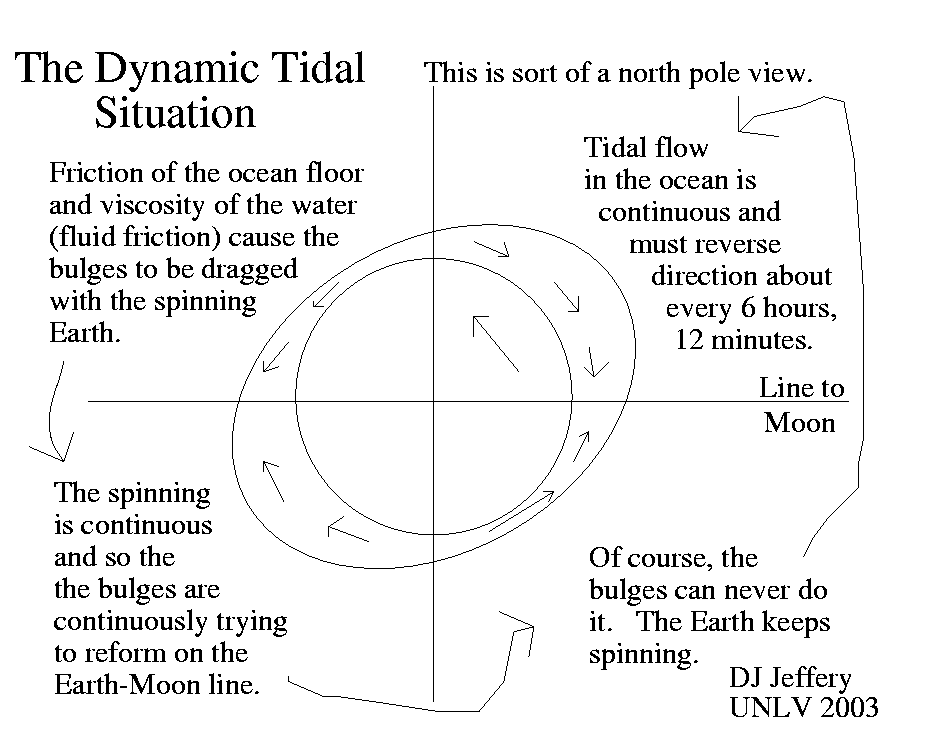
Caption: The dynamic tidal situation.
Credit/Permission: © David Jeffery, 2003 / Own work.
Image link: Itself.
Note, an individual water particle doesn't go very far before the tidal current reverses.
Typically a water particle might go of order 20 km relative to the solid Earth---but the particle is NOT alone.
The whole ocean is sloshing back and forth.
-
Question: Why is the reversal of tidal flow about every
6 hours, 12 minutes and NOT just 6 hours which is a quarter of
a day?
- Friction effects of the ocean floor.
- The Moon is continually moving westward around the Earth.
- The Moon is continually moving eastward around the Earth.
Answer 3 is right.Because of the Moon's continual eastward motion, a water particle on average spends about 6 hours, 12 minutes in each quadrant of the diagram shown above.
So the full tidal cycle of two high tides takes about 24 hours, 50 minutes.
So on average there are fewer than than two high tides a day: most days there will be two, but sometimes there will only be one.
The 24 hours, 50 minutes tidal period, also means that tides will cycle through the whole day: e.g.,
-
If there is a high tide a 12:00 pm today,
there will be one at 12:50 pm tomorrow,
one at 1:40 pm the day after,
and so on. Eventually a tide has occurred at every time of the day.In the open ocean the tidal range (i.e., high to low tide) is typically about 0.5 meters.
The tidal current is 1 to 2 m/s or 4 to 7 km/hr which is NOT too different from walking speed.
Open ocean tides were very hard to measure before satellites with radar ranging. See the figure below.
If you didn't have that you'd have to measure with respect to the bottom of the ocean which can be several kilometers down. Not easy to do very often.
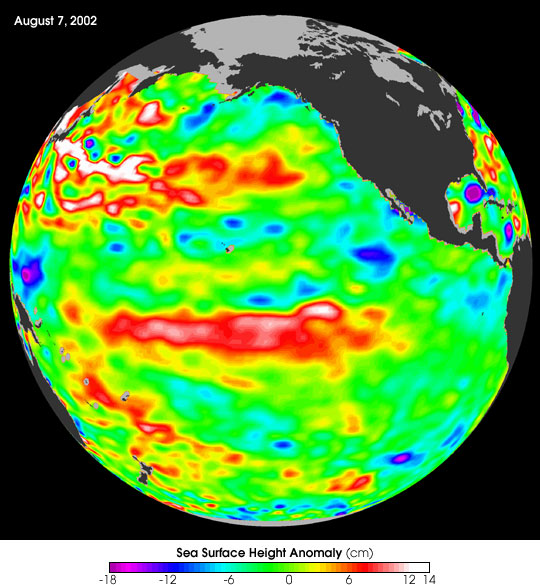
Caption: The kind of satellite mapping that can be done to study tides.
This is NOT a tidal map. It shows sea height relative to mean sea height with tidal variation averaged away.
The sea height changes are dependent on the temperature of the water, and thus on the heat energy stored in the water.
Water is a rather complicated liquid in that it contracts going from 0°C to about 4°C and then expands as temperature increases above 4°C (HRW-432).
-
Global warming could cause sea levels to rise just because
expansion of the water above about 4°C
even if there were no additions from
the melting of the ice caps.
Of course, melting ice caps are the big danger.
The height measurements are done by radar from the TOPEX/Poseidon satellite. This satellite is in a near polar orbit, and so almost all of the Earth is below it at some time or other.
Credit/Permission: NASA, before or circa 2003 / Public domain.
Download site: NASA: Visible Earth: now dead link.
Image link: Itself.
Now above we studied an idealized case where just the MOON has a tidal effect.
The SUN also has tidal effect that is a bit less than half the strength of the Moon's.
-
Question: If there were no Moon, when would the solar high tides occur?
- At noon only.
- At midnight only.
- At noon and midnight only.
Answer 3 is right.There would be tidal bulges peaking near the solar noon and midnight points on the Earth, but dragged somewhat eastward by the Earth's daily rotation.
There are two times when the Moon and Sun tidal effects add up and two times when they partially cancel as illustrated in the igure below (local link / general link: tide_earth.html).
- The varying tilt of the Moon's orbit relative to the Earth's equatorial plane. This is caused by the rotation of the line of nodes.
- The varying distance of the Moon due to the elliptical nature of the Moon and Earth orbits.
- Continents, continental shelfs, coasts, and shallows.
- Permanent ocean currents.
- Seasonal changes.
- Weather.
All these things go on at once, of course, and lead to some very strange effects.
Complicated coast-lines can lead to funny sloshing around. For example:
- The tidal range in the Bay of Fundy in Nova Scotia
gives a tidal range of 12 meters or more and tidal
currents of up to 8 m/s (i.e., about 28 km/hr).
- On the other hand, the Gulf of Mexico tidal range is
only about 0.3 meters and there is only one noticeable
high tide per day.
- In the English Channel, there is a place (Southampton) that has 4 high tides per day due to a backwash effect (CW-385).
Weather can lead to severe problems.
If you have an on-shore storm coinciding with a spring tide, then you can have severe flooding---a TIDAL SURGE.
This is when unstable islands and coastal homes can be washed away.
- Tides in Small Bodies of Water:
Small bodies of water (small seas and lakes), in fact, have measurable tides, but they are usually too minute for humans to notice.
Everything scales down from the oceans.
Even the Mediterranean (which is fairly large) only has noticeable tides in a few places: e.g., Venice.
- Tidal Slowing and Tidal Locking:
The Earth drags the oceans that are trying to form tidal bulges.
But by Newton's 3rd law, this means the oceans drag on the Earth too.

Caption: The dynamic tidal situation.
Credit/Permission: © David Jeffery, 2003 / Own work.
Image link: Itself.
The drag is slowing down the Earth's rotation and increasing the length of the day.
The rate measured over some millennia is about 0.0014 seconds/century (USNO site).
The standard time day is set to be exactly 86400 seconds, where the second is now defined by an atomic clock measurement---and has no connection to astronomical cycles any more.
The mean solar day (i.e., the actual day relative to the Sun) is currently about 86400.002 seconds.
Every 500 or so days a leap second is introduced in standard time to keep standard time and mean solar time consistent.
The international time people in charge of leap seconds (International Earth Rotation Service) usually ordain leap seconds at the beginning of January or July without making much noise about. See the US Naval Observatory's leap second site and past leap second catalog.
Another way of viewing the slowing down of the Earth's rotation is to say that the Earth's rotational kinetic energy is being dissipated to heat---recall friction leads to heating. See the figure below.
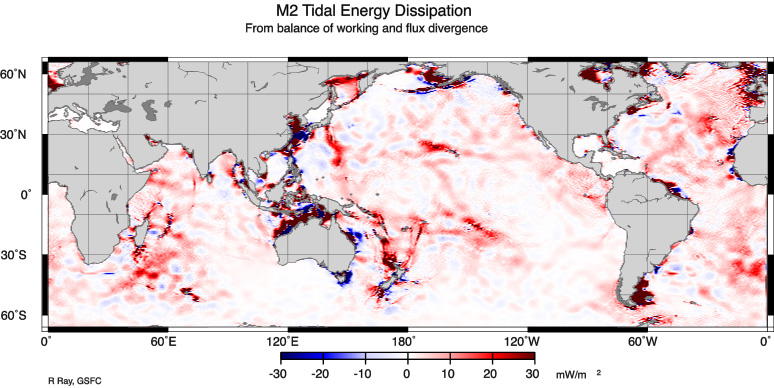
Caption: Dissipation of tidal energy.
The tidal friction with the solid Earth and internally via viscosity dissipates energy that ultimately mostly comes from the rotational energy of the Earth.
The dissipation is complex and may have profound current and climate implications.
The removal of Earth rotational energy is increasing the length of the Earth's day by about 0.0014 seconds per century.
The figure illustrates the tidal dissipation in the ocean in milliwatts per square meter. It isn't clear to me what the zero on the scale represents.
Credit/Permission: NASA, before or circa 2003 / Public domain.
Download site: NASA: Visible Earth: alas, a dead link.
Image link: Itself.
The tidal bulges also have the effect of causing the Moon to spiral away from the Earth to larger orbits with longer periods. See the figure below.
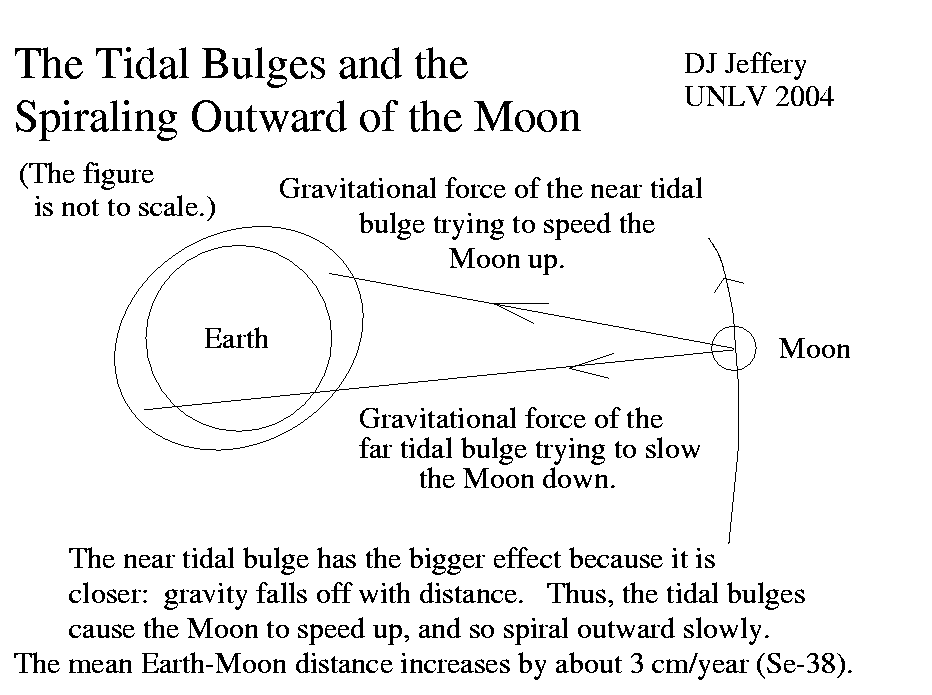
Caption: The tidal bulges and the outward spiraling of the Moon.
Credit/Permission: © David Jeffery, 2004 / Own work.
Image link: Itself.
The Moon's mean distance increases by about 3 cm/year as we know from bouncing laser beams off reflectors left on the Moon by the Apollo missions (Se-38).
About 600 Myr ago---BEFORE dinosaurs ruled the Earth (see figure below)---the Earth's day was only 21 hours long (Wikipedia: Earth's rotation: Tidal interactions), and the Moon was probably significantly closer than today.
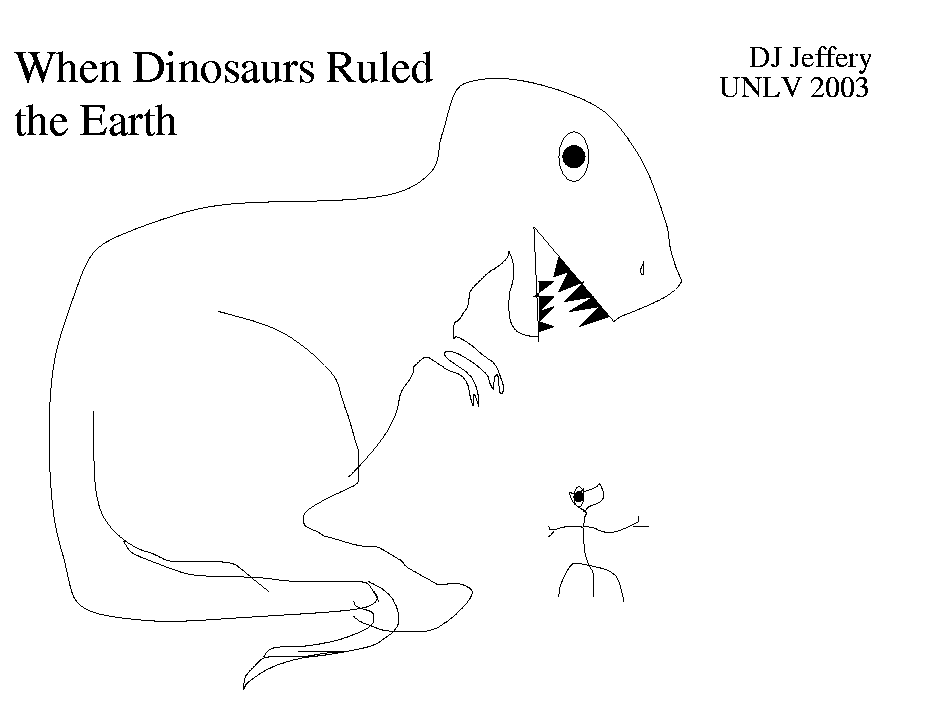
Caption: When dinosaurs ruled the Earth.
Credit/Permission: © David Jeffery, 2003 / Own work.
Image link: Itself.
This can be deduced from the fossil record.
Long in the future---if the Earth lasts that long---the day will be the same length as the lunar month---then maybe 50 days (FMW-75). The Moon then will be farther away.
The Earth will always turn the same face to the Moon---this is just what the Moon does now to the Earth.
This situation is called SYNCHRONOUS TIDAL LOCKING.
In fact, almost all the significant moons in the solar system are already synchronously tidally locked to their planets (Cox-307).
Planet tidal forces on their moons, are much larger than the reverse.
-
Question: Why does no one ever talk about land tides or
atmosphere tides.
- There arn't any.
- They arn't that noticeable.
Answer 2 is right.
They arn't that geologically important on Earth, but they are elsewhere in the solar system.
The tidal force on Jupiter's moon Io makes that body the most geologically active body in the solar system.
Atmospheric tides exist too, but they seem much less important than daily heating and cooling effects of day and night.
Also since we are inside the atmosphere, there is no obvious interface to watch.
They are due to the tidal forces of primarily the Moon and secondarily of the Sun.
Before diving into the tides there two other terrestrial tidal behaviors due to the aforesaid tidal forces that we mention here only in brief:
Now we dive into the tides.
- Flat Space:
Below, we recapitulate some of the topics of Newtonian physics in abbreviated form with some extra points added and some alternative perspectives.
- The Introduction of the Introduction:
